MENU
The Electronic Scholarly Publishing Project: Providing access to classic scientific papers and other scholarly materials, since 1993. More About: ESP | OUR CONTENT | THIS WEBSITE | WHAT'S NEW | WHAT'S HOT
Comparative Timelines
The ESP Timeline (one of the site's most popular features) has been completely updated to allow the user to select (using the timeline controls above each column) different topics for the left and right sides of the display.
Select:
New Left Column
New Left Column
Dates
Decade
New Right Column
New Right Column
(no entry for this year)
1470
(no entry for this year)
(no entry for this year)
1471
(no entry for this year)
(no entry for this year)
1472
(no entry for this year)
(no entry for this year)
1473
(no entry for this year)
(no entry for this year)
1474
(no entry for this year)
(no entry for this year)
1475
(no entry for this year)
(no entry for this year)
1476
(no entry for this year)
(no entry for this year)
1477
(no entry for this year)
(no entry for this year)
1478
(no entry for this year)
(no entry for this year)
1479
(no entry for this year)
(no entry for this year)
1480
(no entry for this year)
(no entry for this year)
1481
(no entry for this year)
(no entry for this year)
1482
(no entry for this year)
(no entry for this year)
1483
(no entry for this year)
(no entry for this year)
1484
(no entry for this year)
(no entry for this year)
1485
(no entry for this year)
(no entry for this year)
1486
(no entry for this year)
(no entry for this year)
1487
(no entry for this year)
(no entry for this year)
1488
(no entry for this year)
(no entry for this year)
1489
(no entry for this year)
(no entry for this year)
1490
(no entry for this year)
(no entry for this year)
1491
(no entry for this year)
(no entry for this year)
1492
(no entry for this year)
(no entry for this year)
1493
(no entry for this year)
Whiskey invented in Scotland.
1494
(no entry for this year)
French gunners begin using cast-iron cannonballs rather than stones.
1495
(no entry for this year)
(no entry for this year)
1496
(no entry for this year)
(no entry for this year)
1497
(no entry for this year)
(no entry for this year)
1498
(no entry for this year)
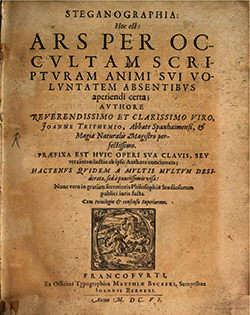 German Benedictine abbot and polymath Johannes Trithemius writes Steganographia, a major work on cryptography. The book is published in 1606. This book is in three volumes, and appears to be about magic — specifically, about using spirits to communicate over long distances. However, since the publication of a decryption key to the first two volumes in 1606, they were discovered to be actually concerned with cryptography and steganography. Until recently, the third volume was widely believed to be solely about magic, but the "magical" formulas have now been shown to be covertexts for yet more material on cryptography. The book was placed on the Index Librorum Prohibitorum in 1609 and removed in 1900.
German Benedictine abbot and polymath Johannes Trithemius writes Steganographia, a major work on cryptography. The book is published in 1606. This book is in three volumes, and appears to be about magic — specifically, about using spirits to communicate over long distances. However, since the publication of a decryption key to the first two volumes in 1606, they were discovered to be actually concerned with cryptography and steganography. Until recently, the third volume was widely believed to be solely about magic, but the "magical" formulas have now been shown to be covertexts for yet more material on cryptography. The book was placed on the Index Librorum Prohibitorum in 1609 and removed in 1900.
1499
(no entry for this year)
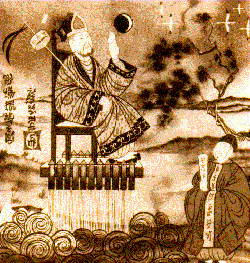 Chinese legendary adventurer Wan Hu attempts to leave the Earth by sitting on a chair with 47 rockets tied to it, holding a kite in each of his hands, and flying into the sky after his servants were ordered to light the fuses to the rockets. But the rockets exploded and Wan Hu was gone when the air cleared. While most authorities consider the story apocryphal, some Chinese scholars believe that foreigners from several different countries in the west were unlikely to fabricate such a story out of thin air. The tale may be based on the stories told by European missionaries who arrived in China since the late Ming dynasty, and then passed on by word of mouth. Alternatively, these European and American scholars may have indirectly relied on records in an ancient Chinese document that has been subsequently lost.
Chinese legendary adventurer Wan Hu attempts to leave the Earth by sitting on a chair with 47 rockets tied to it, holding a kite in each of his hands, and flying into the sky after his servants were ordered to light the fuses to the rockets. But the rockets exploded and Wan Hu was gone when the air cleared. While most authorities consider the story apocryphal, some Chinese scholars believe that foreigners from several different countries in the west were unlikely to fabricate such a story out of thin air. The tale may be based on the stories told by European missionaries who arrived in China since the late Ming dynasty, and then passed on by word of mouth. Alternatively, these European and American scholars may have indirectly relied on records in an ancient Chinese document that has been subsequently lost.
1500
(no entry for this year)
(no entry for this year)
1501
(no entry for this year)
(no entry for this year)
1502
(no entry for this year)
(no entry for this year)
1503
(no entry for this year)
(no entry for this year)
1504
(no entry for this year)
(no entry for this year)
1505
(no entry for this year)
(no entry for this year)
1506
(no entry for this year)
(no entry for this year)
1507
(no entry for this year)
(no entry for this year)
1508
(no entry for this year)
(no entry for this year)
1509
(no entry for this year)
(no entry for this year)
1510
(no entry for this year)
(no entry for this year)
1511
(no entry for this year)
(no entry for this year)
1512
(no entry for this year)
(no entry for this year)
1513
(no entry for this year)
(no entry for this year)
1514
(no entry for this year)
(no entry for this year)
1515
(no entry for this year)
(no entry for this year)
1516
(no entry for this year)
(no entry for this year)
1517
(no entry for this year)
(no entry for this year)
1518
(no entry for this year)
(no entry for this year)
1519
(no entry for this year)
(no entry for this year)
1520
(no entry for this year)
(no entry for this year)
1521
(no entry for this year)
(no entry for this year)
1522
(no entry for this year)
(no entry for this year)
1523
(no entry for this year)
(no entry for this year)
1524
(no entry for this year)
(no entry for this year)
1525
(no entry for this year)
(no entry for this year)
1526
(no entry for this year)
(no entry for this year)
1527
(no entry for this year)
(no entry for this year)
1528
(no entry for this year)
(no entry for this year)
1529
(no entry for this year)
(no entry for this year)
1530
(no entry for this year)
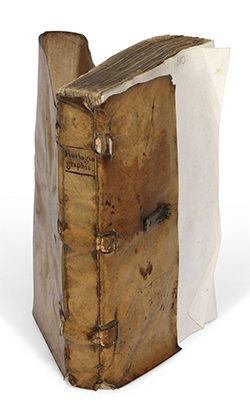 Sebastian Münster publishes Horologiographia, a treatise on the construction of sun dials.
Sebastian Münster publishes Horologiographia, a treatise on the construction of sun dials.
1531
(no entry for this year)
(no entry for this year)
1532
(no entry for this year)
(no entry for this year)
1533
(no entry for this year)
(no entry for this year)
1534
(no entry for this year)
(no entry for this year)
1535
(no entry for this year)
(no entry for this year)
1536
(no entry for this year)
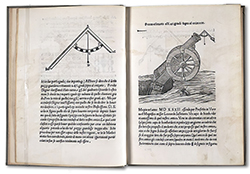 Niccolò Tartaglia publishes Nova Scientia, a treatise on gunnery science. This was Tartaglia's first published work and was described by Matteo Valleriani as: ... one of the most fundamental works on mechanics of the Renaissance, indeed, the first to transform aspects of practical knowledge accumulated by the early modern artillerists into a theoretical and mathematical framework. Then dominant Aristotelian physics preferred categories like "heavy" and "natural" and "violent" to describe motion, generally eschewing mathematical explanations. Tartaglia brought mathematical models to the fore. One of his findings was that the maximum range of a projectile was achieved by directing the cannon at a 45-degree angle to the horizon.
Niccolò Tartaglia publishes Nova Scientia, a treatise on gunnery science. This was Tartaglia's first published work and was described by Matteo Valleriani as: ... one of the most fundamental works on mechanics of the Renaissance, indeed, the first to transform aspects of practical knowledge accumulated by the early modern artillerists into a theoretical and mathematical framework. Then dominant Aristotelian physics preferred categories like "heavy" and "natural" and "violent" to describe motion, generally eschewing mathematical explanations. Tartaglia brought mathematical models to the fore. One of his findings was that the maximum range of a projectile was achieved by directing the cannon at a 45-degree angle to the horizon.
1537
(no entry for this year)
(no entry for this year)
1538
(no entry for this year)
(no entry for this year)
1539
(no entry for this year)
(no entry for this year)
1540
(no entry for this year)
(no entry for this year)
1541
(no entry for this year)
(no entry for this year)
1542
(no entry for this year)
(no entry for this year)
1543
(no entry for this year)
(no entry for this year)
1544
(no entry for this year)
(no entry for this year)
1545
(no entry for this year)
(no entry for this year)
1546
(no entry for this year)
(no entry for this year)
1547
(no entry for this year)
(no entry for this year)
1548
(no entry for this year)
(no entry for this year)
1549
(no entry for this year)
(no entry for this year)
1550
(no entry for this year)
(no entry for this year)
1551
(no entry for this year)
(no entry for this year)
1552
(no entry for this year)
(no entry for this year)
1553
(no entry for this year)
(no entry for this year)
1554
Venetian mathematician Giambattista Benedetti publishes two editions of Demonstratio proportionum motuum localium, developing his new doctrine of the speed of bodies in free fall.
(no entry for this year)
1555
(no entry for this year)
(no entry for this year)
1556
(no entry for this year)
(no entry for this year)
1557
(no entry for this year)
(no entry for this year)
1558
(no entry for this year)
(no entry for this year)
1559
(no entry for this year)
(no entry for this year)
1560
(no entry for this year)
(no entry for this year)
1561
(no entry for this year)
(no entry for this year)
1562
(no entry for this year)
(no entry for this year)
1563
(no entry for this year)
(no entry for this year)
1564
(no entry for this year)
Roger Taverner writes his Arte of Surveyinge.
1565
(no entry for this year)
(no entry for this year)
1566
(no entry for this year)
(no entry for this year)
1567
(no entry for this year)
(no entry for this year)
1568
(no entry for this year)
(no entry for this year)
1569
(no entry for this year)
Giovanni Padovani publishes a detailed treatise on the construction of sundials, Opus de compositione et usu multiformium horologiorum solarium, in Venice.
1570
(no entry for this year)
(no entry for this year)
1571
(no entry for this year)
(no entry for this year)
1572
(no entry for this year)
(no entry for this year)
1573
(no entry for this year)
(no entry for this year)
1574
(no entry for this year)
(no entry for this year)
1575
(no entry for this year)
(no entry for this year)
1576
(no entry for this year)
(no entry for this year)
1577
(no entry for this year)
English seaman William Bourne publishes a manual, Inventions or Devises, Very Necessary for all Generalles and Captaines, as wel by Sea as by Land, including an early theoretical description of a submarine.
1578
(no entry for this year)
(no entry for this year)
1579
(no entry for this year)
(no entry for this year)
1580
(no entry for this year)
(no entry for this year)
1581
(no entry for this year)
(no entry for this year)
1582
(no entry for this year)
(no entry for this year)
1583
(no entry for this year)
(no entry for this year)
1584
(no entry for this year)
(no entry for this year)
1585
(no entry for this year)
(no entry for this year)
1586
Galileo publishes La Billancetta, describing an accurate balance to weigh objects in air or water.
(no entry for this year)
1587
(no entry for this year)
(no entry for this year)
1588
(no entry for this year)
(no entry for this year)
1589
(no entry for this year)
(no entry for this year)
1590
Glass lenses are developed in the Netherlands and used for the first time in microscopes and telescopes.
(no entry for this year)
1591
(no entry for this year)
(no entry for this year)
1592
(no entry for this year)
(no entry for this year)
1593
(no entry for this year)
Bevis Bulmer sets up a system at Blackfriars, London, for pumping a public water supply.
1594
(no entry for this year)
(no entry for this year)
1595
(no entry for this year)
(no entry for this year)
1596
(no entry for this year)
(no entry for this year)
1597
(no entry for this year)
(no entry for this year)
1598
(no entry for this year)
(no entry for this year)
1599
(no entry for this year)
(no entry for this year)
1600
(no entry for this year)
(no entry for this year)
1601
(no entry for this year)
(no entry for this year)
1602
(no entry for this year)
(no entry for this year)
1603
(no entry for this year)
(no entry for this year)
1604
(no entry for this year)
(no entry for this year)
1605
(no entry for this year)
(no entry for this year)
1606
(no entry for this year)
(no entry for this year)
1607
(no entry for this year)
(no entry for this year)
1608
(no entry for this year)
(no entry for this year)
1609
(no entry for this year)
(no entry for this year)
1610
(no entry for this year)
(no entry for this year)
1611
(no entry for this year)
The first flintlock musket likely created for Louis XIII of France by gunsmith Marin Bourgeois.
1612
(no entry for this year)
Richard Braithwaite coined the phrase ‘computer’.
1613
(no entry for this year)
(no entry for this year)
1614
(no entry for this year)
(no entry for this year)
1615
(no entry for this year)
(no entry for this year)
1616
(no entry for this year)
(no entry for this year)
1617
(no entry for this year)
(no entry for this year)
1618
(no entry for this year)
(no entry for this year)
1619
(no entry for this year)
(no entry for this year)
1620
(no entry for this year)
(no entry for this year)
1621
(no entry for this year)
Francis Bacon develops a method of steganography that used an underlying binary code for the letters of the alphabet.
1623
(no entry for this year)
(no entry for this year)
1624
Galileo presents to Cesi, founder of the Lincean Academy, a "little eyeglass" (a microscope). The invention will enable the Linceans to study natural objects with unprecedented precision. They will start with bees, then move on to flies and dust mites.
(no entry for this year)
1625
(no entry for this year)
(no entry for this year)
1626
(no entry for this year)
(no entry for this year)
1627
(no entry for this year)
(no entry for this year)
1628
(no entry for this year)
(no entry for this year)
1629
(no entry for this year)
(no entry for this year)
1630
(no entry for this year)
(no entry for this year)
1631
(no entry for this year)
(no entry for this year)
1632
(no entry for this year)
(no entry for this year)
1633
(no entry for this year)
(no entry for this year)
1634
(no entry for this year)
(no entry for this year)
1635
(no entry for this year)
(no entry for this year)
1636
(no entry for this year)
(no entry for this year)
1637
(no entry for this year)
(no entry for this year)
1638
(no entry for this year)
(no entry for this year)
1639
(no entry for this year)
(no entry for this year)
1640
(no entry for this year)
(no entry for this year)
1641
(no entry for this year)
Pascal's calculator or the Pascaline constructed
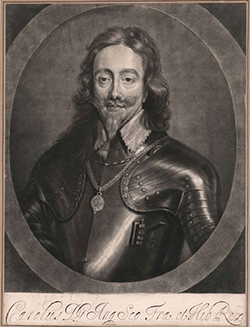 The mezzotint printmaking method was invented by the German amateur artist Ludwig von Siegen. Mezzotint is a printmaking process of the intaglio family, technically a drypoint method. It was the first tonal method to be used, enabling half-tones to be produced without using line- or dot-based techniques like hatching, cross-hatching or stipple. Mezzotint achieves tonality by roughening the plate with thousands of little dots made by a metal tool with small teeth, called a "rocker." In printing, the tiny pits in the plate hold the ink when the face of the plate is wiped clean. A high level of quality and richness in the print can be achieved.
The mezzotint printmaking method was invented by the German amateur artist Ludwig von Siegen. Mezzotint is a printmaking process of the intaglio family, technically a drypoint method. It was the first tonal method to be used, enabling half-tones to be produced without using line- or dot-based techniques like hatching, cross-hatching or stipple. Mezzotint achieves tonality by roughening the plate with thousands of little dots made by a metal tool with small teeth, called a "rocker." In printing, the tiny pits in the plate hold the ink when the face of the plate is wiped clean. A high level of quality and richness in the print can be achieved.
1642
(no entry for this year)
(no entry for this year)
1643
(no entry for this year)
(no entry for this year)
1644
(no entry for this year)
(no entry for this year)
1645
(no entry for this year)
(no entry for this year)
1646
(no entry for this year)
(no entry for this year)
1647
(no entry for this year)
(no entry for this year)
1648
(no entry for this year)
(no entry for this year)
1649
(no entry for this year)
(no entry for this year)
1650
(no entry for this year)
(no entry for this year)
1651
(no entry for this year)
(no entry for this year)
1652
(no entry for this year)
(no entry for this year)
1653
(no entry for this year)
(no entry for this year)
1654
(no entry for this year)
(no entry for this year)
1655
(no entry for this year)
(no entry for this year)
1656
(no entry for this year)
(no entry for this year)
1657
(no entry for this year)
(no entry for this year)
1658
(no entry for this year)
(no entry for this year)
1659
(no entry for this year)
(no entry for this year)
1660
(no entry for this year)
(no entry for this year)
1661
(no entry for this year)
(no entry for this year)
1662
(no entry for this year)
(no entry for this year)
1663
(no entry for this year)
(no entry for this year)
1664
 Isaac Newton discovers that white light is composed of different colors.
Isaac Newton discovers that white light is composed of different colors.
(no entry for this year)
1665
(no entry for this year)
Samuel Morland builds a mechanical calculator that will add and subtract
1666
(no entry for this year)
(no entry for this year)
1667
(no entry for this year)
(no entry for this year)
1668
(no entry for this year)
(no entry for this year)
1669
(no entry for this year)
(no entry for this year)
1670
(no entry for this year)
(no entry for this year)
1671
(no entry for this year)
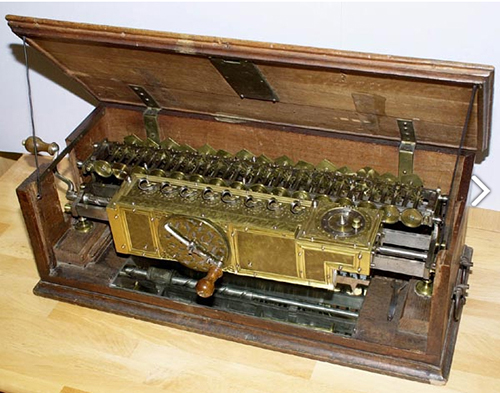 Gottfried Wilhelm von Leibniz invents the Staffelwalze (stepped drum, or stepped reckoner), the first mechanical calculator that could perform all four mathematical operations. Its intricate precision gearwork, however, was somewhat beyond the fabrication technology of the time; mechanical problems, in addition to a design flaw in the carry mechanism, prevented the machines from working reliably. Despite the mechanical flaws, it suggested possibilities to future calculator builders. The operating mechanism, invented by Leibniz, called the stepped cylinder or Leibniz wheel, was used in many calculating machines for 200 years, and into the 1970s with the Curta hand calculator. In discussing his invention, Leibniz wrote Indignum enim est excellentium virorum horas servii calculandi labore perire, qui Machina adhibita vilissimo cuique secure transcribi posset — For it is unworthy of distinguished men to waste their time with slavish calculations, which can be done safely with the use of this machine by anyone else.
Gottfried Wilhelm von Leibniz invents the Staffelwalze (stepped drum, or stepped reckoner), the first mechanical calculator that could perform all four mathematical operations. Its intricate precision gearwork, however, was somewhat beyond the fabrication technology of the time; mechanical problems, in addition to a design flaw in the carry mechanism, prevented the machines from working reliably. Despite the mechanical flaws, it suggested possibilities to future calculator builders. The operating mechanism, invented by Leibniz, called the stepped cylinder or Leibniz wheel, was used in many calculating machines for 200 years, and into the 1970s with the Curta hand calculator. In discussing his invention, Leibniz wrote Indignum enim est excellentium virorum horas servii calculandi labore perire, qui Machina adhibita vilissimo cuique secure transcribi posset — For it is unworthy of distinguished men to waste their time with slavish calculations, which can be done safely with the use of this machine by anyone else.
1672
(no entry for this year)
(no entry for this year)
1673
(no entry for this year)
(no entry for this year)
1674
(no entry for this year)
(no entry for this year)
1675
The English physicist Sir Isaac Newton argues that light is composed of particles, which are refracted by acceleration toward a denser medium, and posits the existence of aether to transmit forces between the particles.
(no entry for this year)
1676
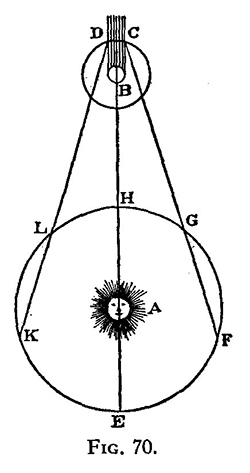 The first quantitative estimate of the speed of light was made in 1676 by Danish astronomer Ole R mer. From the observation that the periods of Jupiter's innermost moon Io appeared to be shorter when the Earth was approaching Jupiter than when receding from it, he concluded that light travels at a finite speed, and estimated that it takes light 22 minutes to cross the diameter of Earth's orbit. Christiaan Huygens combined this estimate with an estimate for the diameter of the Earth's orbit to obtain an estimate of speed of light of 220000 km/s, 26% lower than the actual value.
The first quantitative estimate of the speed of light was made in 1676 by Danish astronomer Ole R mer. From the observation that the periods of Jupiter's innermost moon Io appeared to be shorter when the Earth was approaching Jupiter than when receding from it, he concluded that light travels at a finite speed, and estimated that it takes light 22 minutes to cross the diameter of Earth's orbit. Christiaan Huygens combined this estimate with an estimate for the diameter of the Earth's orbit to obtain an estimate of speed of light of 220000 km/s, 26% lower than the actual value.
(no entry for this year)
1677
(no entry for this year)
(no entry for this year)
1678
(no entry for this year)
(no entry for this year)
1679
(no entry for this year)
(no entry for this year)
1680
(no entry for this year)
(no entry for this year)
1681
(no entry for this year)
(no entry for this year)
1682
(no entry for this year)
(no entry for this year)
1683
(no entry for this year)
(no entry for this year)
1684
(no entry for this year)
(no entry for this year)
1685
(no entry for this year)
(no entry for this year)
1686
(no entry for this year)
(no entry for this year)
1687
(no entry for this year)
(no entry for this year)
1688
(no entry for this year)
(no entry for this year)
1689
(no entry for this year)
(no entry for this year)
1690
(no entry for this year)
(no entry for this year)
1691
(no entry for this year)
(no entry for this year)
1692
(no entry for this year)
(no entry for this year)
1693
(no entry for this year)
(no entry for this year)
1694
(no entry for this year)
(no entry for this year)
1695
(no entry for this year)
(no entry for this year)
1696
(no entry for this year)
(no entry for this year)
1697
(no entry for this year)
(no entry for this year)
1698
(no entry for this year)
(no entry for this year)
1699
(no entry for this year)
(no entry for this year)
1700
(no entry for this year)
(no entry for this year)
1701
(no entry for this year)
(no entry for this year)
1702
(no entry for this year)
Gottfried Wilhelm Leibniz invents the Binary System
1703
(no entry for this year)
(no entry for this year)
1704
(no entry for this year)
(no entry for this year)
1705
(no entry for this year)
(no entry for this year)
1706
(no entry for this year)
(no entry for this year)
1707
(no entry for this year)
(no entry for this year)
1708
(no entry for this year)
(no entry for this year)
1709
(no entry for this year)
Jakob Christoph Le Blon, an engraver, invents three-color printing.
1710
(no entry for this year)
(no entry for this year)
1711
(no entry for this year)
(no entry for this year)
1712
(no entry for this year)
(no entry for this year)
1713
(no entry for this year)
 Daniel Gabriel Fahrenheit constructs a mercury thermometer with a temperature scale.
Daniel Gabriel Fahrenheit constructs a mercury thermometer with a temperature scale.
1714
(no entry for this year)
(no entry for this year)
1715
(no entry for this year)
(no entry for this year)
1716
(no entry for this year)
 Johann Heinrich Schulze makes fleeting sun prints of words by using stencils, sunlight, and a bottled mixture of chalk and silver nitrate in nitric acid, simply as an interesting way to demonstrate that the substance inside the bottle darkens where it is exposed to light.
Johann Heinrich Schulze makes fleeting sun prints of words by using stencils, sunlight, and a bottled mixture of chalk and silver nitrate in nitric acid, simply as an interesting way to demonstrate that the substance inside the bottle darkens where it is exposed to light.
1717
(no entry for this year)
Porcelain is first manufactured in Vienna.
1718
(no entry for this year)
(no entry for this year)
1719
(no entry for this year)
(no entry for this year)
1720
(no entry for this year)
(no entry for this year)
1721
(no entry for this year)
(no entry for this year)
1722
(no entry for this year)
(no entry for this year)
1723
(no entry for this year)
(no entry for this year)
1724
(no entry for this year)
(no entry for this year)
1725
(no entry for this year)
(no entry for this year)
1726
(no entry for this year)
Johann Heinrich Schulze discovered that silver nitrate darkened upon exposure to light.
1727
(no entry for this year)
(no entry for this year)
1728
(no entry for this year)
(no entry for this year)
1729
(no entry for this year)
(no entry for this year)
1730
(no entry for this year)
(no entry for this year)
1731
(no entry for this year)
(no entry for this year)
1732
(no entry for this year)
(no entry for this year)
1733
(no entry for this year)
(no entry for this year)
1734
(no entry for this year)
(no entry for this year)
1735
(no entry for this year)
(no entry for this year)
1736
(no entry for this year)
(no entry for this year)
1737
(no entry for this year)
(no entry for this year)
1738
(no entry for this year)
(no entry for this year)
1739
(no entry for this year)
(no entry for this year)
1740
(no entry for this year)
(no entry for this year)
1741
(no entry for this year)
The Microscope Made Easy, by Henry Baker, introduces the construction and use of the microscope to the layman.
1742
(no entry for this year)
(no entry for this year)
1743
(no entry for this year)
(no entry for this year)
1744
(no entry for this year)
(no entry for this year)
1745
(no entry for this year)
(no entry for this year)
1746
(no entry for this year)
(no entry for this year)
1747
(no entry for this year)
(no entry for this year)
1748
(no entry for this year)
(no entry for this year)
1749
(no entry for this year)
(no entry for this year)
1750
(no entry for this year)
(no entry for this year)
1751
 Benjamin Franklin describes electricity as a single fluid and distinguishes between positive and negative electricity in Experiments and Observations on Electricity. He shows that electricity can magnetize and demagnetize iron needles.
Benjamin Franklin describes electricity as a single fluid and distinguishes between positive and negative electricity in Experiments and Observations on Electricity. He shows that electricity can magnetize and demagnetize iron needles.
(no entry for this year)
1752
 The lightning conductor is invented by Benjamin Franklin, whose experiments with lightning include a flying a kite in a thunderstorm. The kite experiment shows that lightning is a form of electricity, similar to the discharge from a Leyden jar.
The lightning conductor is invented by Benjamin Franklin, whose experiments with lightning include a flying a kite in a thunderstorm. The kite experiment shows that lightning is a form of electricity, similar to the discharge from a Leyden jar.
(no entry for this year)
1753
 Russian scientist Georg Wilhelm Richmann is killed performing a lightning experiment in St. Petersburg. Richmann is electrocuted in while trying to quantify the response of an insulated rod to a nearby storm. The incident, reported worldwide, underscored the dangers inherent in experimenting with insulated rods and in using protective rods with faulty ground connections.
Russian scientist Georg Wilhelm Richmann is killed performing a lightning experiment in St. Petersburg. Richmann is electrocuted in while trying to quantify the response of an insulated rod to a nearby storm. The incident, reported worldwide, underscored the dangers inherent in experimenting with insulated rods and in using protective rods with faulty ground connections.
(no entry for this year)
1754
(no entry for this year)
(no entry for this year)
1755
(no entry for this year)
(no entry for this year)
1756
 William Cullen observes the cooling effect of evaporating liquids and publishes the results in An Essay on the Cold Produced by Evaporating Fluids and Other Means of Producing Cold.
William Cullen observes the cooling effect of evaporating liquids and publishes the results in An Essay on the Cold Produced by Evaporating Fluids and Other Means of Producing Cold.
(no entry for this year)
1757
(no entry for this year)
(no entry for this year)
1758
(no entry for this year)
(no entry for this year)
1759
(no entry for this year)
(no entry for this year)
1760
 Photometria by German physicist Johann Lambert is an investigation of light reflections from planets, introducing the term ALBEDO (whiteness) for the differing reflectivities of planetary bodies.
Photometria by German physicist Johann Lambert is an investigation of light reflections from planets, introducing the term ALBEDO (whiteness) for the differing reflectivities of planetary bodies.
 In experiments with primitive apparatus, Daniel Bernoulli decides that the electrical force obeys an inverse square law similar to that of gravity.
In experiments with primitive apparatus, Daniel Bernoulli decides that the electrical force obeys an inverse square law similar to that of gravity.
(no entry for this year)
1761
 Joseph Black discovers latent heat by finding that ice, when melting, absorbs heat without changing in temperature. Later he measures the latent heat of steam — that is, the heat required to keep water boiling without raising its temperature.
Joseph Black discovers latent heat by finding that ice, when melting, absorbs heat without changing in temperature. Later he measures the latent heat of steam — that is, the heat required to keep water boiling without raising its temperature.
(no entry for this year)
1762
(no entry for this year)
(no entry for this year)
1763
(no entry for this year)
(no entry for this year)
1764
(no entry for this year)
(no entry for this year)
1765
 Leonhard Euler gives a general treatment of the motion of rigid bodies, including the precession and nutation of earth, in Theoria motus corporum solidorum seu rigidorum (Theory of the motion of solid and rigid bodies).
Leonhard Euler gives a general treatment of the motion of rigid bodies, including the precession and nutation of earth, in Theoria motus corporum solidorum seu rigidorum (Theory of the motion of solid and rigid bodies).
 Bifocal spectacles are invented by Benjamin Franklin.
Bifocal spectacles are invented by Benjamin Franklin.
First fire escape patented, consisting of a wicker basket on a pulley and chain.
1766
 Horace-Bénédict de Saussure invents the electrometer, a device for measuring the electric potential by means of the attraction or repulsion of charged bodies.
Horace-Bénédict de Saussure invents the electrometer, a device for measuring the electric potential by means of the attraction or repulsion of charged bodies.
(no entry for this year)
1767
(no entry for this year)
(no entry for this year)
1768
(no entry for this year)
 James Watt patents the modern steam engine, which finds wide use in manufacturing. It is an early milestone of the Industrial Revolution.
James Watt patents the modern steam engine, which finds wide use in manufacturing. It is an early milestone of the Industrial Revolution.
1769
 John Robison measures the repulsion between two charged bodies and shows that this force is inversely proportional to the distance between the two bodies.
John Robison measures the repulsion between two charged bodies and shows that this force is inversely proportional to the distance between the two bodies.
(no entry for this year)
1770
(no entry for this year)
(no entry for this year)
1771
(no entry for this year)
(no entry for this year)
1772
Swedish scientist Johan Carl Wilcke calculates the latent heat of ice (the amount of heat absorbed when ice turns into water).
(no entry for this year)
1773
(no entry for this year)
(no entry for this year)
1774
(no entry for this year)
(no entry for this year)
1775
 Alessandro Volta describes his electrofore perpetuo device for producing and storing a charge of static electricity. This device replaces the Leyden jar and eventually leads to modern electrical condensers.
Alessandro Volta describes his electrofore perpetuo device for producing and storing a charge of static electricity. This device replaces the Leyden jar and eventually leads to modern electrical condensers.
(no entry for this year)
1776
 Pierre-Simon Laplace states that if all of the forces on all objects in any one time are known, then the future can be completely predicted.
Pierre-Simon Laplace states that if all of the forces on all objects in any one time are known, then the future can be completely predicted.
(no entry for this year)
1778
(no entry for this year)
(no entry for this year)
1779
(no entry for this year)
(no entry for this year)
1780
(no entry for this year)
(no entry for this year)
1781
Johan Carl Wilcke introduces the concept of SPECIFIC HEAT.
 Coloumb's Théorie des machiones simple (Theory of simple machines) is a study of friction.
Coloumb's Théorie des machiones simple (Theory of simple machines) is a study of friction.
(no entry for this year)
1782
(no entry for this year)
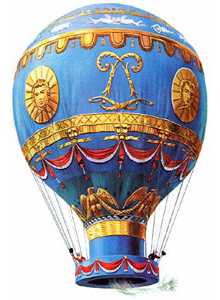 Joseph and Jacques Montgolfier make first public balloon flight.
Joseph and Jacques Montgolfier make first public balloon flight.
1783
 Horace-Bénédict de Saussure's Essais sur l'hygromé (Essay on measuring humidity) describes how to construct a hygrometer from human hair that can measure relative humidity.
Horace-Bénédict de Saussure's Essais sur l'hygromé (Essay on measuring humidity) describes how to construct a hygrometer from human hair that can measure relative humidity.
(no entry for this year)
1784
George Atwood accurately determines the acceleration of a free-falling body.
First balloon flight across English Channel (Jean-Pierre Blanchard and John Jeffries).
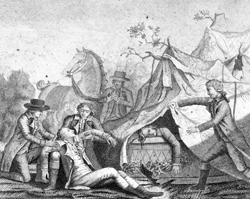 French balloonists Jean-François Pilatre de Rozier and Jules Romain are killed when their Royal Balloon crashes near Boulogne, France, June 15, 1785, in what is considered the first aerial disaster.
French balloonists Jean-François Pilatre de Rozier and Jules Romain are killed when their Royal Balloon crashes near Boulogne, France, June 15, 1785, in what is considered the first aerial disaster.
1785
 Couloumb makes precise measurements of the forces of attraction and repulsion between charged bodies and between magnetic poles, using a torsion balance, demonstrating conclusively that electric charge and magnetism obey inverse-square laws like that of gravity. He also discovers that electrically charged bodies discharge spontaneously. In the 20th century, it is found that cosmic radiation is responsible for this discharge.
Couloumb makes precise measurements of the forces of attraction and repulsion between charged bodies and between magnetic poles, using a torsion balance, demonstrating conclusively that electric charge and magnetism obey inverse-square laws like that of gravity. He also discovers that electrically charged bodies discharge spontaneously. In the 20th century, it is found that cosmic radiation is responsible for this discharge.
(no entry for this year)
1786
(no entry for this year)
(no entry for this year)
1787
 Jacques-Alexandre Charles shows that different gases expand by the same amount for a given rise in temperature (Charles Law).
Jacques-Alexandre Charles shows that different gases expand by the same amount for a given rise in temperature (Charles Law).
(no entry for this year)
1788
(no entry for this year)
Bourbon Whiskey is first created by Elijah Craig in Bourbon, Kentucky.
1789
The French chemist Antoine-Laurent de Lavoisier definitively states the Law of Conservation of Mass (although others had previously expressed similar ideas, including the ancient Greek Epicurus, the medieval Persian Nasir al-Din al-Tusi and the 18th Century scientists Mikhail Lomonosov, Joseph Black, Henry Cavendish and Jean Rey), and identifies (albeit slightly incorrectly) 23 elements which he claims can not be broken down into simpler substances.
(no entry for this year)
1790
(no entry for this year)
Charles Babbage is Born
John Stone, Concord, Massachusetts, patents a pile driver.
 New York City traffic regulation creates first one-way street.
New York City traffic regulation creates first one-way street.
1791
 Luigi Galvani announces that electricity applied to severed frog's legs causes them to twitch and that frogs legs twitch in the presence of two different metals with no electric current present. The latter discovery eventually leads to Alessandro Volta's developing the electric battery.
Luigi Galvani announces that electricity applied to severed frog's legs causes them to twitch and that frogs legs twitch in the presence of two different metals with no electric current present. The latter discovery eventually leads to Alessandro Volta's developing the electric battery.
 Pierre Prévost develops his theory of exchanges of radiation of heat. He correctly shows that cold is merely the absence of heat and that all bodies continually radiate heat. If they seem not to radiate heat, it means that they are in heat equilibrium with their environment.
Pierre Prévost develops his theory of exchanges of radiation of heat. He correctly shows that cold is merely the absence of heat and that all bodies continually radiate heat. If they seem not to radiate heat, it means that they are in heat equilibrium with their environment.
Guillotine first used (to execute highwayman Nicolas J. Pelletier).
1792
(no entry for this year)
France becomes first country to use the metric system.
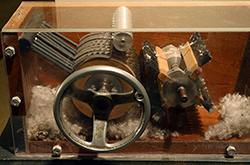 Eli Whitney invents the cotton gin (cotton enGINe), a machine that quickly and easily separates cotton fibers from their seeds, allowing for much greater productivity than manual cotton separation. By reducing the labor of removing seeds, the cotton gin made cotton growing more profitable, thereby raising demand for slave labor. The first federal census of 1790 counted 697,897 slaves; by 1810, there were 1.2 million slaves, a 70 percent increase. Slavery spread from the seaboard to some of the new western territories and states as new cotton fields were planted, and by 1830 it thrived in more than half the continent. Within 10 years after the cotton gin was put into use, the value of the total United States crop leaped from $150,000 to more than $8 million.
Eli Whitney invents the cotton gin (cotton enGINe), a machine that quickly and easily separates cotton fibers from their seeds, allowing for much greater productivity than manual cotton separation. By reducing the labor of removing seeds, the cotton gin made cotton growing more profitable, thereby raising demand for slave labor. The first federal census of 1790 counted 697,897 slaves; by 1810, there were 1.2 million slaves, a 70 percent increase. Slavery spread from the seaboard to some of the new western territories and states as new cotton fields were planted, and by 1830 it thrived in more than half the continent. Within 10 years after the cotton gin was put into use, the value of the total United States crop leaped from $150,000 to more than $8 million.
1793
(no entry for this year)
(no entry for this year)
1794
 Alessandro Volta demonstrates that the electric force observed by Galvani is not connected with living creatures, but can be obtained whenever two different metals are placed in a conducting fluid.
Alessandro Volta demonstrates that the electric force observed by Galvani is not connected with living creatures, but can be obtained whenever two different metals are placed in a conducting fluid.
(no entry for this year)
1795
(no entry for this year)
(no entry for this year)
1796
(no entry for this year)
(no entry for this year)
1797
(no entry for this year)
(no entry for this year)
1798
Henry Cavendish determines the mass of Earth by measuring the gravity between two small masses and two large masses. This gives the gravitational constant G, which was the only unknown in Newton's equations. Solving for G enables Cavendish to establish that Earth is about 5.5 times as dense as water.
 Enquiry concerning the source of heat which is excited by friction by Count Rumford (Benjamin Thompson) describes his experiments with boring cannons that show that the caloric theory of heat cannot be true, and that heat should be considered a kind of motion.
Enquiry concerning the source of heat which is excited by friction by Count Rumford (Benjamin Thompson) describes his experiments with boring cannons that show that the caloric theory of heat cannot be true, and that heat should be considered a kind of motion.
(no entry for this year)
1799
(no entry for this year)
 Thomas Wedgwood conceives of making permanent pictures of camera images by using a durable surface coated with a light-sensitive chemical. He succeeds only in producing silhouettes and other shadow images, and is unable to make them permanent.
Thomas Wedgwood conceives of making permanent pictures of camera images by using a durable surface coated with a light-sensitive chemical. He succeeds only in producing silhouettes and other shadow images, and is unable to make them permanent.
1800
 Alessandro Volta announces his invention, made in 1799, of the electric battery, also known as the Voltaic pile. It consists of a stack of alternating zinc and silver discs separated by felt soaked in brine. It is the first source of a steady electric current.
Alessandro Volta announces his invention, made in 1799, of the electric battery, also known as the Voltaic pile. It consists of a stack of alternating zinc and silver discs separated by felt soaked in brine. It is the first source of a steady electric current.
 William Herschel's "An investigation of the powers of prismatic colors to heat and illuminate objects" tells of his discovery of infrared radiation. While investigating the power of different parts of the spectrum to heat a thermometer, he finds that invisible light beyond the red produces the most heat.
William Herschel's "An investigation of the powers of prismatic colors to heat and illuminate objects" tells of his discovery of infrared radiation. While investigating the power of different parts of the spectrum to heat a thermometer, he finds that invisible light beyond the red produces the most heat.
(no entry for this year)
1801
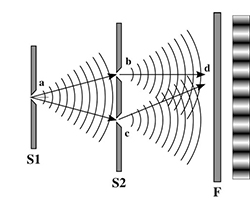 The English scientist Thomas Young demonstrates, in his famous double-slit experiment, the interference of light and concludes that light is a wave, not a particle as Sir Isaac Newton had ruled.
The English scientist Thomas Young demonstrates, in his famous double-slit experiment, the interference of light and concludes that light is a wave, not a particle as Sir Isaac Newton had ruled.
(no entry for this year)
1802
 Thomas Young's On the theory of light and colors is the first of three pivotal papers describing his wave theory of light.
Thomas Young's On the theory of light and colors is the first of three pivotal papers describing his wave theory of light.
(no entry for this year)
1803
(no entry for this year)
(no entry for this year)
1804
John Leslie's An experimental inquiry into the nature and propagation of heat establishes that the transmission of heat through radiation has the same properties as the propagation of light.
(no entry for this year)
1805
 Pierre-Simon Laplace measures molecular forces in liquids and announces his theory of capillary forces.
Pierre-Simon Laplace measures molecular forces in liquids and announces his theory of capillary forces.
The English chemist John Dalton develops his atomic theory, proposing that each chemical element is composed of atoms of a single unique type, and that, though they are both immutable and indestructible, they can combine to form more complex structures.
(no entry for this year)
1806
(no entry for this year)
 Robert Fulton develops the first practical steamboat, the Clermont, which sails from New York City to Albany and back.
Robert Fulton develops the first practical steamboat, the Clermont, which sails from New York City to Albany and back.
1807
 Thomas Young introduces the concept of, and is the first to use the word, ENERGY.
Thomas Young introduces the concept of, and is the first to use the word, ENERGY.
(no entry for this year)
1808
 Étienne-Louis Malus discovers that reflected light is polarized and introduces the term POLARIZATION.
Étienne-Louis Malus discovers that reflected light is polarized and introduces the term POLARIZATION.
(no entry for this year)
1809
(no entry for this year)
(no entry for this year)
1810
(no entry for this year)
(no entry for this year)
1811
(no entry for this year)
(no entry for this year)
1812
 William Hyde Wollaston invents the camera lucida, a device for projecting an image onto a flat surface, such as drawing paper, on which the object can then be traced.
William Hyde Wollaston invents the camera lucida, a device for projecting an image onto a flat surface, such as drawing paper, on which the object can then be traced.
(no entry for this year)
1813
(no entry for this year)
(no entry for this year)
1814
(no entry for this year)
Ada, Lady Lovelace, is Born
1815
(no entry for this year)
 Nic phore Ni pce succeeds in making negative photographs of camera images on paper coated with silver chloride, but cannot adequately "fix" them to stop them from darkening all over when exposed to light for viewing.
Nic phore Ni pce succeeds in making negative photographs of camera images on paper coated with silver chloride, but cannot adequately "fix" them to stop them from darkening all over when exposed to light for viewing.
1816
 Augustin Fresnel demonstrates with his mirror experiment the wave nature of light. He also gives an explanation of polarization.
Augustin Fresnel demonstrates with his mirror experiment the wave nature of light. He also gives an explanation of polarization.
(no entry for this year)
1817

 Thomas Young and Augustin Fresnel demonstrated that light waves must be transverse vibrations.
Thomas Young and Augustin Fresnel demonstrated that light waves must be transverse vibrations.
(no entry for this year)
1818
(no entry for this year)
(no entry for this year)
1819
(no entry for this year)
The Arithmometer was the first commercially successful mechanical calculator patented
1820
 André-Marie Ampère formulates one of the basic laws of electromagnetism, the right-hand rule for the influence of an electric current on the magnet and demonstrates that two wires that are carrying an electric current will attract or repel each other, depending on whether the occurrence are in opposite where the same directions.
André-Marie Ampère formulates one of the basic laws of electromagnetism, the right-hand rule for the influence of an electric current on the magnet and demonstrates that two wires that are carrying an electric current will attract or repel each other, depending on whether the occurrence are in opposite where the same directions.
 Dominique-François Arago discovers the magnetic effect of electricity passing through a copper wire, demonstrating that iron is not necessary for magnetism.
Dominique-François Arago discovers the magnetic effect of electricity passing through a copper wire, demonstrating that iron is not necessary for magnetism.
 Augustin-Jean Fresnel invents the so-called Fresnel lens, a lens used in lighthouses.
Augustin-Jean Fresnel invents the so-called Fresnel lens, a lens used in lighthouses.
 The science of electrodynamics is born with the announcement of Hans Christian Ørsted's discovery of electromagnetism.
The science of electrodynamics is born with the announcement of Hans Christian Ørsted's discovery of electromagnetism.
 Michael Faraday invents the electric motor and generator.
Michael Faraday invents the electric motor and generator.
1821
(no entry for this year)
Charles Babbage takes first steps in the construction of machines that would compute numbers
 Nic phore Ni pce abandons silver halide photography as hopelessly impermanent and tries using thin coatings of Bitumen of Judea on metal and glass. He creates the first fixed, permanent photograph, a copy of an engraving of Pope Pius VII, by contact printing in direct sunlight without a camera or lens. It is later destroyed; the earliest surviving example of his "heliographic process" is from 1825.
Nic phore Ni pce abandons silver halide photography as hopelessly impermanent and tries using thin coatings of Bitumen of Judea on metal and glass. He creates the first fixed, permanent photograph, a copy of an engraving of Pope Pius VII, by contact printing in direct sunlight without a camera or lens. It is later destroyed; the earliest surviving example of his "heliographic process" is from 1825.
1822
(no entry for this year)
 Physicist Michael Faraday (1791-1867) describes the liquification of chlorine in On fluid chlorine. Faraday finds that gasses of certain kinds, when kept under constant pressure, will condense until they cool. This latter discovery ushers in the beginning of mechanical methods of refrigeration.
Physicist Michael Faraday (1791-1867) describes the liquification of chlorine in On fluid chlorine. Faraday finds that gasses of certain kinds, when kept under constant pressure, will condense until they cool. This latter discovery ushers in the beginning of mechanical methods of refrigeration.
Small-scale drilling for oil begins at Baku, a Russian port city on the west coast of the Caspian Sea, now the capital of Azerbaijan. The drilling marks the beginning of the modern petroleum industry, and by 1900 nearly half the world's oil will come from the Baku oil fields.
1823
(no entry for this year)
 Nic phore Ni pce makes the first durable, light-fast camera photograph, similar to his surviving 1826-1827 photograph on pewter but created on the surface of a lithographic stone. It is destroyed in the course of subsequent experiments.
Nic phore Ni pce makes the first durable, light-fast camera photograph, similar to his surviving 1826-1827 photograph on pewter but created on the surface of a lithographic stone. It is destroyed in the course of subsequent experiments.
1824
 Réflexions sur la puissance motrice du feu (On the motive power of fire) by Nicolas Léonard Sadi Carnot shows that work is done as heat passes from a high temperature to a low temperature; defines work; hints at the second law of thermodynamics; and suggests internal combustion engines.
Réflexions sur la puissance motrice du feu (On the motive power of fire) by Nicolas Léonard Sadi Carnot shows that work is done as heat passes from a high temperature to a low temperature; defines work; hints at the second law of thermodynamics; and suggests internal combustion engines.
The Erie Canal (from Albany to Buffalo, New York) opens on October 26, connecting the Midwestern U.S. with the Atlantic Ocean, via the Great Lakes, and stimulating the development of Fort Dearborn (know today as Chicago), Cleveland and Columbus Ohio, and upstate New York cities like Rochester, Syracuse and Little Falls.
The first passenger steam railway opens, between Stockton and Darlington, England.
1825
(no entry for this year)
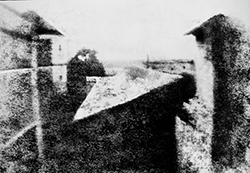 Photograph by Joseph Ni pce: View from the Window at Le Gras, the world's first permanent photograph.
Photograph by Joseph Ni pce: View from the Window at Le Gras, the world's first permanent photograph.
 The first photographic images produced by Joseph-Nicéphore Ni pce
The first photographic images produced by Joseph-Nicéphore Ni pce
1826
(no entry for this year)
(no entry for this year)
1827
 Theory of systems of rays by William Rowan Hamilton is a unification of the study of optics through the principle of "varying action". It contains his correct prediction of conical refraction. When his prediction is verified, he becomes a well-known and is knighted.
Theory of systems of rays by William Rowan Hamilton is a unification of the study of optics through the principle of "varying action". It contains his correct prediction of conical refraction. When his prediction is verified, he becomes a well-known and is knighted.
(no entry for this year)
1828
(no entry for this year)
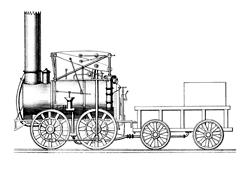 The first steam locomotive to operate on a U.S. railroad begins service between Carbondale and Honesdale, Pennsylvania. The engine, "The Stourbridge Lion", has been imported from the Stephenson Engine Works in London.
The first steam locomotive to operate on a U.S. railroad begins service between Carbondale and Honesdale, Pennsylvania. The engine, "The Stourbridge Lion", has been imported from the Stephenson Engine Works in London.
1829
 Gustave-Gaspard Coriolis coins the term KINETIC ENERGY in On the calculation of mechanical action.
Gustave-Gaspard Coriolis coins the term KINETIC ENERGY in On the calculation of mechanical action.
 Joseph Henry shows that passing an electric current through a wire wrapped into coils produces a greater magnetic field than is produced when that same current is passed through a straight wire, and that an insulated wire wrapped around an iron core can produce a powerful electromagnet.
Joseph Henry shows that passing an electric current through a wire wrapped into coils produces a greater magnetic field than is produced when that same current is passed through a straight wire, and that an insulated wire wrapped around an iron core can produce a powerful electromagnet.
(no entry for this year)
1830
(no entry for this year)
(no entry for this year)
1831
Independently, Michael Faraday and Joseph Henry discover that electricity can be induced by changes in a magnetic field (electromagnetic induction), a discovery leading to the first electric generators.
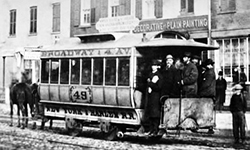 In November, the New York and Harlem Railroad begins service, and heralds the start of rapid mass transit in New York City. Two horse-drawn rail cars operate every 15 minutes between 14th Street and Prince Street, along the Bowery. The fare is 25 cents.
In November, the New York and Harlem Railroad begins service, and heralds the start of rapid mass transit in New York City. Two horse-drawn rail cars operate every 15 minutes between 14th Street and Prince Street, along the Bowery. The fare is 25 cents.
1832
(no entry for this year)
Ada Lovelace Meets Charles Babbage
1833

 In correspondence, Michael Faraday and William Whewell introduce the terms ELECTRODE, ANODE, ION, CATHODE, ANION, CATION, ELECTROLYTE, and ELECTROLYSIS.
In correspondence, Michael Faraday and William Whewell introduce the terms ELECTRODE, ANODE, ION, CATHODE, ANION, CATION, ELECTROLYTE, and ELECTROLYSIS.
 H rcules Florence, a French-Brazilian painter and the isolate inventor of photography in Brazil, coined the word photographie for his technique, at least four years before John Herschel coined the English word photography.
H rcules Florence, a French-Brazilian painter and the isolate inventor of photography in Brazil, coined the word photographie for his technique, at least four years before John Herschel coined the English word photography.
 Charles Babbage invents the "analytical engine" — the forerunner of the modern computer.
Charles Babbage invents the "analytical engine" — the forerunner of the modern computer.
1834
 Mathematician Carl Friedrich Gauss (1777-1855) shows that the origin of the Earth's magnetic field must lie deep inside the Earth. He makes use of the measurements of the magnetic field made by the physicist Paul Erman in 1828.
Mathematician Carl Friedrich Gauss (1777-1855) shows that the origin of the Earth's magnetic field must lie deep inside the Earth. He makes use of the measurements of the magnetic field made by the physicist Paul Erman in 1828.
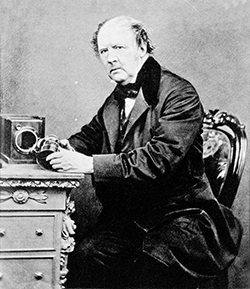 Henry Fox Talbot produces durable silver chloride camera negatives on paper and conceives the two-step negative-positive procedure used in most non-electronic photography up to the present.
Henry Fox Talbot produces durable silver chloride camera negatives on paper and conceives the two-step negative-positive procedure used in most non-electronic photography up to the present.
1835
 Gustave-Gaspard Coriolis's Mémoire sur les equations du mouvement relatif des sytèms de corps (Memoir on the equations of relative movement of systems of bodies) describes the Coriolis effect: the deflection of a moving body caused by Earth's rotation. The Coriolis effect is important in the study of wind. However, the claim that the Coriolis effect determines the direction water rotates when going down a drain is a myth.
Gustave-Gaspard Coriolis's Mémoire sur les equations du mouvement relatif des sytèms de corps (Memoir on the equations of relative movement of systems of bodies) describes the Coriolis effect: the deflection of a moving body caused by Earth's rotation. The Coriolis effect is important in the study of wind. However, the claim that the Coriolis effect determines the direction water rotates when going down a drain is a myth.
Alonzo D. Phillips, a shoemaker from Springfield, Massachusetts, patents the phosphorous match.
1836
 John Frederic Danielle invents the Daniell cell, the first reliable source of electric current, based on the interactions of copper and zinc.
John Frederic Danielle invents the Daniell cell, the first reliable source of electric current, based on the interactions of copper and zinc.
Charles Babbage published a paper describing a mechanical computer that is now known as the Analytical Engine
 Samuel F. B. Morse sends his first message by electric telegraph — "What hath God wrought!" — on an experimental line between Washington DC and Baltimore, Maryland.
Samuel F. B. Morse sends his first message by electric telegraph — "What hath God wrought!" — on an experimental line between Washington DC and Baltimore, Maryland.
1837
(no entry for this year)
The S.S. Sirius and the S. S. Great Western are the first ships powered entirely by steam to cross the Atlantic. Both ships are designed by engineer Isambard Kingdom Brunel (1806-1859).
1838
(no entry for this year)
 Louis-Jacques-Mand Daguerre perfects and presents the daguerreotype process as the first publicly available photographic process (which for nearly twenty years was also the one most commonly used). To make the image, a daguerreotypist would polish a sheet of silver-plated copper to a mirror finish, treat it with fumes that made its surface light sensitive, expose it in a camera for as long as was judged to be necessary, which could be as little as a few seconds for brightly sunlit subjects or much longer with less intense lighting; make the resulting latent image on it visible by fuming it with mercury vapor; remove its sensitivity to light by liquid chemical treatment, rinse and dry it, then seal the easily marred result behind glass in a protective enclosure.
Louis-Jacques-Mand Daguerre perfects and presents the daguerreotype process as the first publicly available photographic process (which for nearly twenty years was also the one most commonly used). To make the image, a daguerreotypist would polish a sheet of silver-plated copper to a mirror finish, treat it with fumes that made its surface light sensitive, expose it in a camera for as long as was judged to be necessary, which could be as little as a few seconds for brightly sunlit subjects or much longer with less intense lighting; make the resulting latent image on it visible by fuming it with mercury vapor; remove its sensitivity to light by liquid chemical treatment, rinse and dry it, then seal the easily marred result behind glass in a protective enclosure.
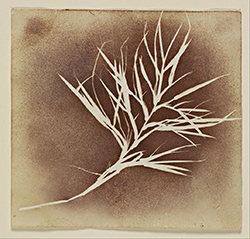 Henry Fox Talbot publicly introduces the paper-based process he worked out in 1835, calling it "photogenic drawing", but it requires much longer exposures than the daguerreotype and the results are not as clear and detailed.
Henry Fox Talbot publicly introduces the paper-based process he worked out in 1835, calling it "photogenic drawing", but it requires much longer exposures than the daguerreotype and the results are not as clear and detailed.
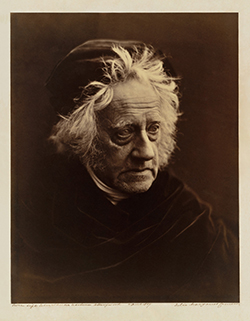 John Herschel introduces hyposulfite of soda (now known as sodium thiosulfate but still nicknamed "hypo") as a highly effective fixer for all silver-based processes. He also makes the first glass negative.
John Herschel introduces hyposulfite of soda (now known as sodium thiosulfate but still nicknamed "hypo") as a highly effective fixer for all silver-based processes. He also makes the first glass negative.
 Sarah Anne Bright creates a series of photograms, six of which are known to still exist. These are the earliest surviving photographic images created by a woman.
Sarah Anne Bright creates a series of photograms, six of which are known to still exist. These are the earliest surviving photographic images created by a woman.
 Although a bicycle consisting of a frame and wheels has existed for years, blacksmith Kirkpatrick MacMillan (1813-1878), introduces the first bicycle in its modern form, with brakes and pedals. The bike has iron tires and weighs nearly 60 pounds.
Although a bicycle consisting of a frame and wheels has existed for years, blacksmith Kirkpatrick MacMillan (1813-1878), introduces the first bicycle in its modern form, with brakes and pedals. The bike has iron tires and weighs nearly 60 pounds.
 Inventor Erastus Brigham Bigelow (1814-1879) introduces the power loom in Massachusetts.
Inventor Erastus Brigham Bigelow (1814-1879) introduces the power loom in Massachusetts.
 The first electric clock is built by physicist Carl August Steinheil (1801-1870).
The first electric clock is built by physicist Carl August Steinheil (1801-1870).
1839
The English scientist Michael Faraday concludes from his work on electromagnetism that, contrary to scientific opinion of the time, the divisions between the various kinds of electricity are illusory. He also establishes that magnetism can affect rays of light, and that there is an underlying relationship between the two phenomena.
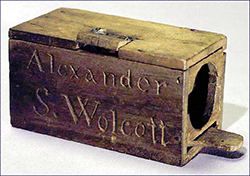 First American patent issued in photography to Alexander Wolcott for his camera.
First American patent issued in photography to Alexander Wolcott for his camera.
 The first postage stamp, called the "Penny Black" and bearing the image of Queen Victoria, is issued in England.
The first postage stamp, called the "Penny Black" and bearing the image of Queen Victoria, is issued in England.
 The oil-immersion microscope is invented by Giovanni Battista Amici (1786-1863), a former professor of mathematics who is now the director of the observatory at the Royal Museum in Florence, and an astronomer to the Grand Duke of Tuscany. The objective lens of this microscope is immersed in a drop of oil which sits on top of the object under study; this helps to minimize aberrations caused by the light source.
The oil-immersion microscope is invented by Giovanni Battista Amici (1786-1863), a former professor of mathematics who is now the director of the observatory at the Royal Museum in Florence, and an astronomer to the Grand Duke of Tuscany. The objective lens of this microscope is immersed in a drop of oil which sits on top of the object under study; this helps to minimize aberrations caused by the light source.
1840
 Alexandre-Edmond Becquerel shows that light can initiate chemical reactions that produce an electric current.
Alexandre-Edmond Becquerel shows that light can initiate chemical reactions that produce an electric current.
 William Henry Talbot patents the Calotype process, the first negative-positive process making possible the first multiple copies.
William Henry Talbot patents the Calotype process, the first negative-positive process making possible the first multiple copies.
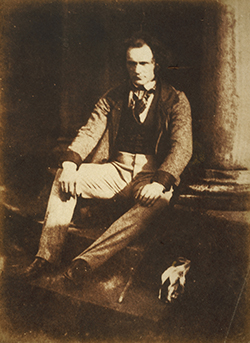 Henry Fox Talbot introduces his patented calotype (or "talbotype") paper negative process, an improved version of his earlier process that greatly reduces the required exposure time.
Henry Fox Talbot introduces his patented calotype (or "talbotype") paper negative process, an improved version of his earlier process that greatly reduces the required exposure time.
In Paris, street lights made from arc lamps are demonstrated.
1841
(no entry for this year)
(no entry for this year)
1842
 German physician and physicist Julius Robert Mayer is the first to state the law of conservation of energy, noting specifically that heat and mechanical energy are two aspects of the same thing.
German physician and physicist Julius Robert Mayer is the first to state the law of conservation of energy, noting specifically that heat and mechanical energy are two aspects of the same thing.
 On the uniform motion of heat in homogeneous solid bodies, by William Thomson, aka Lord Kelvin (1824-1907), is published. Thomson's concern with the physics of cooling bodies will draw him into debates concerning the age of the Earth. In 1846 he calculates that the Earth can be no more than 100 million years old.
On the uniform motion of heat in homogeneous solid bodies, by William Thomson, aka Lord Kelvin (1824-1907), is published. Thomson's concern with the physics of cooling bodies will draw him into debates concerning the age of the Earth. In 1846 he calculates that the Earth can be no more than 100 million years old.
 The change in the observed frequency of waves emitted from a source, moving relative to the observer, is described by Christian Johann Doppler (1803-1853). This phenomenon is now known as the Doppler Effect.
The change in the observed frequency of waves emitted from a source, moving relative to the observer, is described by Christian Johann Doppler (1803-1853). This phenomenon is now known as the Doppler Effect.
 Jerome Increase Case, a 24 year-old farmer from Oswego County, New York, introduces the J. I. Case Threshing Machine. The J. I. Case Company will manufacture farm equipment and will become the largest thresher producer in the world.
Jerome Increase Case, a 24 year-old farmer from Oswego County, New York, introduces the J. I. Case Threshing Machine. The J. I. Case Company will manufacture farm equipment and will become the largest thresher producer in the world.
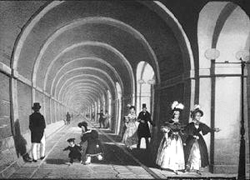 The first tunnel under the Thames opens on March 25, built by Isambard Kingdom Brunel (1806-1859). {a]The Thames Tunnel{/a} connects Rotherhithe and Wapping, London. Although it was a triumph of civil engineering, the Thames Tunnel was not a financial success. It had cost a fortune to build — £454,000 to dig and another £180,000 to fit out — far exceeding its initial cost estimates. Proposals to extend the entrance to accommodate wheeled vehicles failed owing to cost, and it was only used by pedestrians. It became a major tourist attraction, attracting about two million people a year, each paying a penny to pass through.
The first tunnel under the Thames opens on March 25, built by Isambard Kingdom Brunel (1806-1859). {a]The Thames Tunnel{/a} connects Rotherhithe and Wapping, London. Although it was a triumph of civil engineering, the Thames Tunnel was not a financial success. It had cost a fortune to build — £454,000 to dig and another £180,000 to fit out — far exceeding its initial cost estimates. Proposals to extend the entrance to accommodate wheeled vehicles failed owing to cost, and it was only used by pedestrians. It became a major tourist attraction, attracting about two million people a year, each paying a penny to pass through.
1843
 James Prescott Joule determines the mechanical equivalent of heat by measuring the rise in temperature produced in water by stirring it.
James Prescott Joule determines the mechanical equivalent of heat by measuring the rise in temperature produced in water by stirring it.
 In Hartford, Connecticut, dentist Horace Wells (1815-1848) uses nitrous oxide as an anesthetic; he is the first to do so.
In Hartford, Connecticut, dentist Horace Wells (1815-1848) uses nitrous oxide as an anesthetic; he is the first to do so.
1844
(no entry for this year)
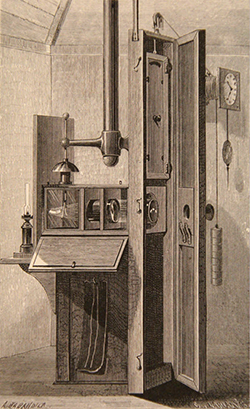 Francis Ronalds invents the first successful camera for continuous recording (the first "movie camera") of the variations in meteorological and geomagnetic parameters over time. A copy of Ronalds' paper describing describing his device maybe obtained HERE.
Francis Ronalds invents the first successful camera for continuous recording (the first "movie camera") of the variations in meteorological and geomagnetic parameters over time. A copy of Ronalds' paper describing describing his device maybe obtained HERE.
 The bridge spanning the Allegheny River, at Pittsburgh, designed by engineer John Augustus Roebling (1806-1869), opens in May. It is the first wire cable suspension aqueduct bridge in the world.
The bridge spanning the Allegheny River, at Pittsburgh, designed by engineer John Augustus Roebling (1806-1869), opens in May. It is the first wire cable suspension aqueduct bridge in the world.
1845
 Michael Faraday relates magnetism to light after finding the magnetic field effects the polarization of light in crystals. He proposes that light may be waves of electromagnetism. He also describes the phenomena of diamagnetism and paramagnetism, which he explains in terms of his concept of a magnetic field.
Michael Faraday relates magnetism to light after finding the magnetic field effects the polarization of light in crystals. He proposes that light may be waves of electromagnetism. He also describes the phenomena of diamagnetism and paramagnetism, which he explains in terms of his concept of a magnetic field.
 Nitroglycerine is discovered by chemist Ascanio Sobrero (1811-1870), although he uses to term "pyroglycerine". Because of the risks involved in its production, it will not be manufactured commercially for more than a decade.
Nitroglycerine is discovered by chemist Ascanio Sobrero (1811-1870), although he uses to term "pyroglycerine". Because of the risks involved in its production, it will not be manufactured commercially for more than a decade.
 The lock-stitch sewing machine is patented by Elias Howe (1819-1867).
The lock-stitch sewing machine is patented by Elias Howe (1819-1867).
1846
 James Prescott Joule discovers that the length of an iron bar changes slightly when the bar is magnetized.
James Prescott Joule discovers that the length of an iron bar changes slightly when the bar is magnetized.
 The rotary, or "lightning" printing press is patented by Richard March Hoe (1812-1886). It is used first by the Philadelphia Public Ledger.
The rotary, or "lightning" printing press is patented by Richard March Hoe (1812-1886). It is used first by the Philadelphia Public Ledger.
1847
 Über die Erhaltung der Kraft ("On the Conservation of Force"), by Hermann Ludwig von Helmholtz (1821-1894), is published. It articulates what later becomes known as the Conservation of Energy.
Über die Erhaltung der Kraft ("On the Conservation of Force"), by Hermann Ludwig von Helmholtz (1821-1894), is published. It articulates what later becomes known as the Conservation of Energy.
 Edmond Becquerel makes the first full-color photographs, but they are only laboratory curiosities: an exposure lasting hours or days is required and the colors are so light-sensitive that they sometimes fade right before the viewer's eyes while being examined.
Edmond Becquerel makes the first full-color photographs, but they are only laboratory curiosities: an exposure lasting hours or days is required and the colors are so light-sensitive that they sometimes fade right before the viewer's eyes while being examined.
1848
 An absolute scale of temperatures is proposed by William Thomson (1824-1907). Thomson will become Baron Kelvin of Largs, in 1892, and the scale will come to bear his name.
An absolute scale of temperatures is proposed by William Thomson (1824-1907). Thomson will become Baron Kelvin of Largs, in 1892, and the scale will come to bear his name.
 Armand Hippolyte Louis Fizeau suggests that light from a source of moving away from the observer will be shifted toward the red end of the spectrum, a phenomenon known as redshift. This is closely related to, but not exactly the same as, the Doppler effect.
Armand Hippolyte Louis Fizeau suggests that light from a source of moving away from the observer will be shifted toward the red end of the spectrum, a phenomenon known as redshift. This is closely related to, but not exactly the same as, the Doppler effect.
 A unmanned Montgolfier balloon is used to drop bombs on Venice. This is the first time a bombing has been conducted from the air.
A unmanned Montgolfier balloon is used to drop bombs on Venice. This is the first time a bombing has been conducted from the air.
1849
 Armand Hippolyte Louis Fizeau measures the velocity of light in error by measuring the time it takes for a beam of light to pass between the teeth of a rotating gear. The light is reflected by a mirror and stopped by the next tooth of the gear. The result, 315,000 km/se4c (196,000 miles/sec), is within 5% of today's accepted value.
Armand Hippolyte Louis Fizeau measures the velocity of light in error by measuring the time it takes for a beam of light to pass between the teeth of a rotating gear. The light is reflected by a mirror and stopped by the next tooth of the gear. The result, 315,000 km/se4c (196,000 miles/sec), is within 5% of today's accepted value.
 In describing Sadi Carnot's theory of heat, published in 1824, William Thomson (1824-1907) uses the term THERMODYNAMICS.
In describing Sadi Carnot's theory of heat, published in 1824, William Thomson (1824-1907) uses the term THERMODYNAMICS.
 The speed of light is measured by physicist Armand Hippolyte Louis Fizeau (1819-1896) to be approximately 186,000 miles per second.
The speed of light is measured by physicist Armand Hippolyte Louis Fizeau (1819-1896) to be approximately 186,000 miles per second.
 "Bibless overalls" made of canvas are sold by the 20 year-old Levi Strauss in San Francisco. Within three years he will switch to denim and dye his pants indigo blue.
"Bibless overalls" made of canvas are sold by the 20 year-old Levi Strauss in San Francisco. Within three years he will switch to denim and dye his pants indigo blue.
1850
 In Über die bewegende Kraft der Wärme, mathematical physicist Rudolf Julius Emanuel Clausius articulates what comes to be known as the Second Law of Thermodynamics. The law states that heat can only be transferred from a warmer body to a colder body. In 1865, he'll restate the Law, saying that in the closed system entropy always increases.
In Über die bewegende Kraft der Wärme, mathematical physicist Rudolf Julius Emanuel Clausius articulates what comes to be known as the Second Law of Thermodynamics. The law states that heat can only be transferred from a warmer body to a colder body. In 1865, he'll restate the Law, saying that in the closed system entropy always increases.
Arithmometer: first commercially successful mechanical calculator launched
 The fast-acting Collodion process invented by Frederick Scott Archer. Images require only two or three seconds of light exposure. Collodion process, mostly synonymous with the "collodion wet plate process", requires the photographic material to be coated, sensitized, exposed and developed within the span of about fifteen minutes, necessitating a portable darkroom for use in the field. Collodion is normally used in its wet form, but can also be used in humid ("preserved") or dry form, at the cost of greatly increased exposure time. The latter made the dry form unsuitable for the usual portraiture work of most professional photographers of the 19th century. The use of the dry form was therefore mostly confined to landscape photography and other special applications where minutes-long exposure times were tolerable.
The fast-acting Collodion process invented by Frederick Scott Archer. Images require only two or three seconds of light exposure. Collodion process, mostly synonymous with the "collodion wet plate process", requires the photographic material to be coated, sensitized, exposed and developed within the span of about fifteen minutes, necessitating a portable darkroom for use in the field. Collodion is normally used in its wet form, but can also be used in humid ("preserved") or dry form, at the cost of greatly increased exposure time. The latter made the dry form unsuitable for the usual portraiture work of most professional photographers of the 19th century. The use of the dry form was therefore mostly confined to landscape photography and other special applications where minutes-long exposure times were tolerable.
 Isaac Singer patents the continuous-stitch sewing machine.
Isaac Singer patents the continuous-stitch sewing machine.
The Erie Railroad, now controlled by Daniel Drew, becomes the first rail line connecting the Great Lakes with New York City, and begins to compete with the Erie Canal as a transportation route.
1851
 Léon Foucault demonstrates that the Earth rotates using a pendulum, suspended from the ceiling of a church.
Léon Foucault demonstrates that the Earth rotates using a pendulum, suspended from the ceiling of a church.
 Physicist William Thomson proposes a concept of "absolute zero", at which the energy of molecules is zero. He draws on Charles' Law to show that such a condition would hold at -273 degrees Celsius.
Physicist William Thomson proposes a concept of "absolute zero", at which the energy of molecules is zero. He draws on Charles' Law to show that such a condition would hold at -273 degrees Celsius.
In South Bend, Indiana, Clement and Henry Studebaker found Studebaker Brothers. Joined by a third brother, John, in 1858, the company will become the world's largest maker of wagons and carriages.
 In Sweden, safety matches are patented by J. E. Lundstrom.
In Sweden, safety matches are patented by J. E. Lundstrom.
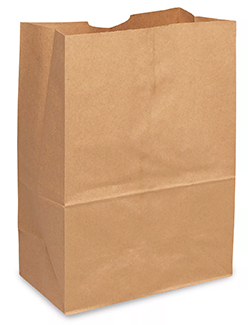 The brown paper bag is invented.
The brown paper bag is invented.
The elevator is invented, facilitating the future development of skyscrapers.
The U.S. state of Pennsylvania adopts a non-standard railroad gauge in order to prevent New York's Erie Railroad from establishing a route, through Pennsylvania, to Ohio.
1852

 James Prescott Joule and William Thompson, later Lord Kelvin, establish that an expanding gas becomes cooler. This is now known as the Joule-Thompson effect.
James Prescott Joule and William Thompson, later Lord Kelvin, establish that an expanding gas becomes cooler. This is now known as the Joule-Thompson effect.
1853
 Léon Foucault demonstrates that the velocity of light is lesson water than in air, tending to confirm the wave theory of light.
Léon Foucault demonstrates that the velocity of light is lesson water than in air, tending to confirm the wave theory of light.
 William John Macquorn Rankine introduces the concept of potential energy, or energy of position.
William John Macquorn Rankine introduces the concept of potential energy, or energy of position.
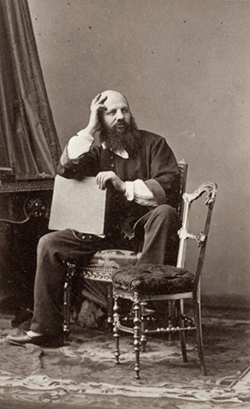 Andr -Adolphe-Eug ne Disd ri credited with introduction of the carte de visite (English: visiting card or calling card) format for portraiture. Disd ri uses a camera with multiple lenses that can photograph eight different poses on one large negative. After printing on albumen paper, the images are cut apart and glued to calling-card-size mounts. Photographs had previously served as calling cards, but Disd ri's invention of the paper carte de visite (i.e. "visiting card") enabled the mass production of photographs. On 27 November 1854 he patented the system of printing ten photographs on a single sheet (although there is no evidence that a system printing more than eight actually materialized). Disd ri's's cartes de visite were 6 9 cm, about the size of conventional (nonphotographic) visiting cards of the time, and were made by a camera with four lenses and a sliding plate holder; a design inspired by the stereoscopic cameras. The novelty quickly spread throughout the world. According to a German visitor, Disd ri's studio became "really the Temple of Photography - a place unique in its luxury and elegance. Daily he sells three to four thousand francs worth of portraits". The fact that these photos could be reproduced inexpensively and in great quantity brought about the decline of the daguerreotype and ushered in a carte de visite craze as they became enormously popular throughout Europe and the United States. Disd ri also invented the twin-lens reflex camera.
Andr -Adolphe-Eug ne Disd ri credited with introduction of the carte de visite (English: visiting card or calling card) format for portraiture. Disd ri uses a camera with multiple lenses that can photograph eight different poses on one large negative. After printing on albumen paper, the images are cut apart and glued to calling-card-size mounts. Photographs had previously served as calling cards, but Disd ri's invention of the paper carte de visite (i.e. "visiting card") enabled the mass production of photographs. On 27 November 1854 he patented the system of printing ten photographs on a single sheet (although there is no evidence that a system printing more than eight actually materialized). Disd ri's's cartes de visite were 6 9 cm, about the size of conventional (nonphotographic) visiting cards of the time, and were made by a camera with four lenses and a sliding plate holder; a design inspired by the stereoscopic cameras. The novelty quickly spread throughout the world. According to a German visitor, Disd ri's studio became "really the Temple of Photography - a place unique in its luxury and elegance. Daily he sells three to four thousand francs worth of portraits". The fact that these photos could be reproduced inexpensively and in great quantity brought about the decline of the daguerreotype and ushered in a carte de visite craze as they became enormously popular throughout Europe and the United States. Disd ri also invented the twin-lens reflex camera.
1854
(no entry for this year)

 A mercury pump is developed by inventor Heinrich Geissler, to produce vacuum tubes. The first cathode rays will be observed in these tubes, after they are modified and improved by Sir William Crookes.
A mercury pump is developed by inventor Heinrich Geissler, to produce vacuum tubes. The first cathode rays will be observed in these tubes, after they are modified and improved by Sir William Crookes.
 Engineer Frederick Taylor carries out "time-motion" studies of workers with the idea of making their labor more efficient. He will pioneer the "scientific management" of the workplace.
Engineer Frederick Taylor carries out "time-motion" studies of workers with the idea of making their labor more efficient. He will pioneer the "scientific management" of the workplace.
1855
(no entry for this year)
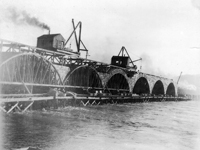 A railway bridge spanning the Mississippi opens between Rockville, Illinois, and Davenport, Iowa. Abraham Lincoln, a lawyer, will defend the legality of the bridge before the Supreme Court, in response to a "right of way" suit brought by a steamship company.
A railway bridge spanning the Mississippi opens between Rockville, Illinois, and Davenport, Iowa. Abraham Lincoln, a lawyer, will defend the legality of the bridge before the Supreme Court, in response to a "right of way" suit brought by a steamship company.
 During Easter vacation from London's Royal College of Chemistry, 18-year-old William Henry Perkin synthesized mauve, or aniline purple — the first synthetic dyestuff — from chemicals derived from coal tar. Mauve was enthusiastically adopted by the fashion industry in England and synthetic dyes quickly destroyed the market for natural substances derived from plants like indigo and madder. Perkin's creation was an accident — he was trying to synthesize quinine.
During Easter vacation from London's Royal College of Chemistry, 18-year-old William Henry Perkin synthesized mauve, or aniline purple — the first synthetic dyestuff — from chemicals derived from coal tar. Mauve was enthusiastically adopted by the fashion industry in England and synthetic dyes quickly destroyed the market for natural substances derived from plants like indigo and madder. Perkin's creation was an accident — he was trying to synthesize quinine.
 The "Bessemer process" for making inexpensive steel, which involves using blasts of cold air to decarbonize melted pig iron, is developed by inventor Henry Bessemer.
The "Bessemer process" for making inexpensive steel, which involves using blasts of cold air to decarbonize melted pig iron, is developed by inventor Henry Bessemer.
The 458-mile Wabash and Erie Canal opens after 24 years, and is the largest canal ever dug in the U.S. By 1860, however, sections will begin to be close, and, unable to compete for railroads, the entire Canal will be closed by 1874.
1856
(no entry for this year)
 In Burrville, Connecticut, commercial production of Gail Borden's patented "condensed milk" begins. The product is made from skim milk, without any fat and without a number of nutrients found in cow's milk.
In Burrville, Connecticut, commercial production of Gail Borden's patented "condensed milk" begins. The product is made from skim milk, without any fat and without a number of nutrients found in cow's milk.
In California, Tokay, Zinfandel, and Shiraz grapes (all from Hungary) are first planted, and Italian honeybees are introduced. This is the beginning of the U.S. wine and honey industries. In North America, honey bees are an artificially introduced and invasive species.
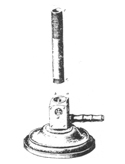 Robert Wilhelm von Bunsen (along with Henry Roscoe) publish a design for a laboratory burner in Poggendorff's Annalen der Physik und Chemie, 100:84-85.
Robert Wilhelm von Bunsen (along with Henry Roscoe) publish a design for a laboratory burner in Poggendorff's Annalen der Physik und Chemie, 100:84-85.
1857
 Über die Art der Bewegung, welche wir Wäe nennen (On the type of motion turned heat) by Rudolf Clausius is establishes his kinetic theory of heat of the mathematical basis. It also explains how evaporation occurs.
Über die Art der Bewegung, welche wir Wäe nennen (On the type of motion turned heat) by Rudolf Clausius is establishes his kinetic theory of heat of the mathematical basis. It also explains how evaporation occurs.
J. Schweppe & Co. Ltd. patents a quinine tonic water that they will begin selling in 1880.
 John Landis Mason patents a reusable glass jar.
John Landis Mason patents a reusable glass jar.
1858
 Julius Plücker shows that cathode rays bend under the influence of a magnet, suggesting they are connected in some way with charge. This is an early step along the path that will lead in 1897 to the discovery that cathode rays are composed of electrons.
Julius Plücker shows that cathode rays bend under the influence of a magnet, suggesting they are connected in some way with charge. This is an early step along the path that will lead in 1897 to the discovery that cathode rays are composed of electrons.
 In Titusville, Pennsylvania, commercial production of petroleum begins, with drilling of the first well by Edwin Laurentine Drake. The well will produce approximately 400 gallons/day.
In Titusville, Pennsylvania, commercial production of petroleum begins, with drilling of the first well by Edwin Laurentine Drake. The well will produce approximately 400 gallons/day.
 The first internal combustion engine is developed by Jean-Joseph-Etienne Lenoir. The engine uses coal gas.
The first internal combustion engine is developed by Jean-Joseph-Etienne Lenoir. The engine uses coal gas.
1859
 Gustav Kirchoff recognizes that sodium is found on the sun and discovers his black-body radiation law.
Gustav Kirchoff recognizes that sodium is found on the sun and discovers his black-body radiation law.

 Physicist Gustav Robert Kirchhoff and chemist R. W. Bunsen explain that when light passes through a gas, or heated material, only certain wavelengths of the light are absorbed. Therefore, an analysis of the spectrum of the light can reveal the chemical makeup of the gas or material.
Physicist Gustav Robert Kirchhoff and chemist R. W. Bunsen explain that when light passes through a gas, or heated material, only certain wavelengths of the light are absorbed. Therefore, an analysis of the spectrum of the light can reveal the chemical makeup of the gas or material.
Herman Hollerith was born 29th February 1860
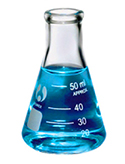 Emil Erlenmeyer invents the flask.
Emil Erlenmeyer invents the flask.
1860
(no entry for this year)
 Oliver Wendell Holmes invents stereoscope viewer
Oliver Wendell Holmes invents stereoscope viewer
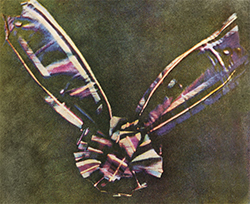 James Clerk Maxwell presents a projected additive color image of a multicolored ribbon, the first demonstration of color photography by the three-color method he suggested in 1855. It uses three separate black-and-white photographs taken and projected through red, green and blue color filters. The projected image is temporary but the set of three "color separations" is the first durable color photograph.
James Clerk Maxwell presents a projected additive color image of a multicolored ribbon, the first demonstration of color photography by the three-color method he suggested in 1855. It uses three separate black-and-white photographs taken and projected through red, green and blue color filters. The projected image is temporary but the set of three "color separations" is the first durable color photograph.
1861
(no entry for this year)
(no entry for this year)
1862
(no entry for this year)
(no entry for this year)
1863
(no entry for this year)
(no entry for this year)
1864
 James Clerk Maxwell's A dynamical theory of the electromagnetic field is the first of his publications to use Michael Faraday's concept of a field as the basis of the mathematical treatment of electricity and magnetism. It introduces Maxwell's equations to describe electromagnetism.
James Clerk Maxwell's A dynamical theory of the electromagnetic field is the first of his publications to use Michael Faraday's concept of a field as the basis of the mathematical treatment of electricity and magnetism. It introduces Maxwell's equations to describe electromagnetism.
(no entry for this year)
1865
 Rudolf Clausius invents the term ENTROPY to describe the degradation of energy in the closed system.
Rudolf Clausius invents the term ENTROPY to describe the degradation of energy in the closed system.
(no entry for this year)
1866
(no entry for this year)
(no entry for this year)
1867
(no entry for this year)
 Louis Ducos du Hauron patents his numerous ideas for color photography based on the three-color principle, including procedures for making subtractive color prints on paper. They are published the following year. Their implementation is not technologically practical at that time, but they anticipate most of the color processes that are later introduced.
Louis Ducos du Hauron patents his numerous ideas for color photography based on the three-color principle, including procedures for making subtractive color prints on paper. They are published the following year. Their implementation is not technologically practical at that time, but they anticipate most of the color processes that are later introduced.
Wallace Clement Ware Sabine becomes the first acoustical engineer and uses acoustic principles to design Boston's Symphony Hall.
1868
(no entry for this year)
(no entry for this year)
1869
(no entry for this year)
(no entry for this year)
1870
(no entry for this year)
Richard Leach Maddox invents the gelatin dry plate silver bromide process. Negatives no longer had to be developed immediately. Long before his discovery of the dry gelatin photographic emulsion, Maddox was prominent in what was called photomicrography - photographing minute organisms under the microscope. The eminent photomicrographer of the day, Lionel S. Beale, included as a frontispiece images made by Maddox in his manual 'How to work with the Microscope'.
1871
 George Johnstone Stoney notes that the wavelengths of three lines in the hydrogen spectrum are found to have simple ratios, and anticipation of Balmer's formula, an important step towards understanding the structure of the atom.
George Johnstone Stoney notes that the wavelengths of three lines in the hydrogen spectrum are found to have simple ratios, and anticipation of Balmer's formula, an important step towards understanding the structure of the atom.
 James Clerk Maxwell explains how his statistical theory of heat works by inventing MAXWELL'S DEMON, a mythical creature that can see and handle individual molecules. By opening a gate between two vessels containing a gas only one of fast molecules passing into one, the demon would make heat flow from cold to hot.
James Clerk Maxwell explains how his statistical theory of heat works by inventing MAXWELL'S DEMON, a mythical creature that can see and handle individual molecules. By opening a gate between two vessels containing a gas only one of fast molecules passing into one, the demon would make heat flow from cold to hot.
(no entry for this year)
1872
(no entry for this year)
QWERTY keyboard invented
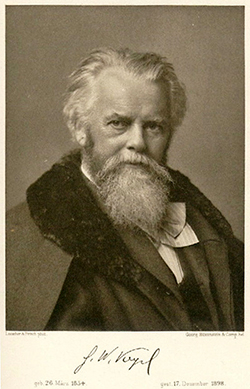 Hermann Wilhelm Vogel discovers dye sensitization, allowing the blue-sensitive but otherwise color-blind photographic emulsions then in use to be made sensitive to green, yellow and red light. Technical problems delay the first use of dye sensitization in a commercial product until the mid-1880s; fully panchromatic emulsions are not in common use until the mid-20th century.
Hermann Wilhelm Vogel discovers dye sensitization, allowing the blue-sensitive but otherwise color-blind photographic emulsions then in use to be made sensitive to green, yellow and red light. Technical problems delay the first use of dye sensitization in a commercial product until the mid-1880s; fully panchromatic emulsions are not in common use until the mid-20th century.
1873
 James Clerk Maxwell's Electricity and Magnetism contains the basic laws of electromagnetism and predicts, in great detail, such phenomena as radio waves and pressure caused by light rays.
James Clerk Maxwell's Electricity and Magnetism contains the basic laws of electromagnetism and predicts, in great detail, such phenomena as radio waves and pressure caused by light rays.
Thomas J. Watson Sr. is born
The first electric tram operates in New York City.
1874
 Irish physicist George J. Stoney estimates the charge of the then unknown electron to be about 10-20 coulomb, close to the modern value of 1.6021892 x 10-19. He also introduces the term ELECTRON.
Irish physicist George J. Stoney estimates the charge of the then unknown electron to be about 10-20 coulomb, close to the modern value of 1.6021892 x 10-19. He also introduces the term ELECTRON.
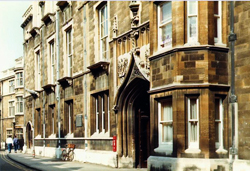 The Cavendish laboratory at Cambridge is completed. Although widely believed to have been named after the 18th-century physicist Henry Cavendish, it is, in fact, named after the entire Cavendish family, because the 19th century steel-making descendent of Henry, William Cavendish, financed the laboratory. The structure of DNA was worked out at the Cavendish many years later by Watson and Crick.
The Cavendish laboratory at Cambridge is completed. Although widely believed to have been named after the 18th-century physicist Henry Cavendish, it is, in fact, named after the entire Cavendish family, because the 19th century steel-making descendent of Henry, William Cavendish, financed the laboratory. The structure of DNA was worked out at the Cavendish many years later by Watson and Crick.
(no entry for this year)
1875
(no entry for this year)

 Ferdinand Hurter and Vero Charles Driffield begin systematic evaluation of sensitivity characteristics of photographic emulsions the science of sensitometry. They also invent a photographic exposure estimation device known as an actinograph. In 1920, William Bates Ferguson edits a memorial volume: The Photographic Researches of Ferdinand Hurter & Vero C. Driffield: Being a Reprint of Their Published Papers, Together With a History of Their Early Work & a Bibliography of Later Work on the Same Subject.
Ferdinand Hurter and Vero Charles Driffield begin systematic evaluation of sensitivity characteristics of photographic emulsions the science of sensitometry. They also invent a photographic exposure estimation device known as an actinograph. In 1920, William Bates Ferguson edits a memorial volume: The Photographic Researches of Ferdinand Hurter & Vero C. Driffield: Being a Reprint of Their Published Papers, Together With a History of Their Early Work & a Bibliography of Later Work on the Same Subject.
1876
 Eugen Goldstein shows that the radiation in a vacuum tube produced when an electric current is forced through the tube starts at the cathode. Goldstein introduces the term CATHODE RAY to describe the light emitted.
Eugen Goldstein shows that the radiation in a vacuum tube produced when an electric current is forced through the tube starts at the cathode. Goldstein introduces the term CATHODE RAY to describe the light emitted.
 Phonograph Invented by Edison On December 15th, Thomas Edison applied for a patent for his phonograph. Edison initially believed it would be used to record business sessions, or family voices. Edison became famous with this invention and was invited to the White House for a demonstration.
Phonograph Invented by Edison On December 15th, Thomas Edison applied for a patent for his phonograph. Edison initially believed it would be used to record business sessions, or family voices. Edison became famous with this invention and was invited to the White House for a demonstration.
1877
(no entry for this year)
Willgodt T. Odhner granted a patent for a calculating machine
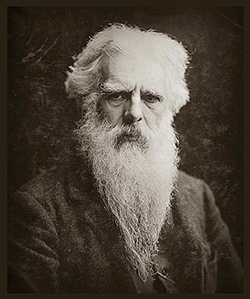 Eadweard Muybridge uses a row of cameras with trip-wires to make a high-speed photographic analysis of a galloping horse. Each picture is taken in less than the two-thousandth part of a second, and they are taken in sufficiently rapid sequence (about 25 per second) that they constitute a brief real-time "movie" that can be viewed by using a device such as a zoetrope, a photographic "first".
Eadweard Muybridge uses a row of cameras with trip-wires to make a high-speed photographic analysis of a galloping horse. Each picture is taken in less than the two-thousandth part of a second, and they are taken in sufficiently rapid sequence (about 25 per second) that they constitute a brief real-time "movie" that can be viewed by using a device such as a zoetrope, a photographic "first".
Heat ripening of gelatin emulsions is discovered. This greatly increases sensitivity and makes possible very short "snapshot" exposures.
 The world's first oil tanker — the Zoroaster — is launched, in the Caspian Sea. The ship was designed by Ludvig Nobel, the brother of Alfred Nobel.
The world's first oil tanker — the Zoroaster — is launched, in the Caspian Sea. The ship was designed by Ludvig Nobel, the brother of Alfred Nobel.
The first electric street lighting appears, in London.
1878
(no entry for this year)
(no entry for this year)
1879
(no entry for this year)
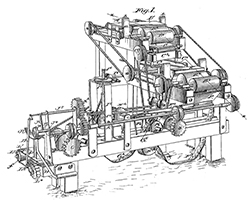 James Albert Bonsack invents the first automated cigarette-rolling machine after seeing a tobacco company offer a prize for the first machine to roll and cut a cigarette. The Bonsack machine could roll up to 210 cigarettes per minute, compared to the average of four cigarettes per minute that could be rolled by hand. The Bonsack machine revolutionized the cigarette industry by making it possible to mass-produce inexpensive cigarettes.
James Albert Bonsack invents the first automated cigarette-rolling machine after seeing a tobacco company offer a prize for the first machine to roll and cut a cigarette. The Bonsack machine could roll up to 210 cigarettes per minute, compared to the average of four cigarettes per minute that could be rolled by hand. The Bonsack machine revolutionized the cigarette industry by making it possible to mass-produce inexpensive cigarettes.
1880
 Pierre Curie discovers the piezoelectric effect: certain substances produce an electric current when they are physically distorted, and conversely they are physically distorted when an electric current is applied to them. This effect has many applications, including, in the 21st century, the construction of high-end tweeters in stereo systems.
Pierre Curie discovers the piezoelectric effect: certain substances produce an electric current when they are physically distorted, and conversely they are physically distorted when an electric current is applied to them. This effect has many applications, including, in the 21st century, the construction of high-end tweeters in stereo systems.
(no entry for this year)
1881
 Hermann Ludwig von Helmholtz shows that the electrical charges in atoms are divided into definite integral portions, suggesting the idea that there is a smallest unit of electricity.
Hermann Ludwig von Helmholtz shows that the electrical charges in atoms are divided into definite integral portions, suggesting the idea that there is a smallest unit of electricity.
The first hydro-electric plant opens, in Wisconsin.
1882
 John William Strutt, Lord Rayleigh, discovers that the ratio of the atomic mass of oxygen to that of hydrogen is not 16 exactly, as had been assumed, but 15.882.
John William Strutt, Lord Rayleigh, discovers that the ratio of the atomic mass of oxygen to that of hydrogen is not 16 exactly, as had been assumed, but 15.882.
Scheutz invents the first printing calculator
 German engineer Gottlieb Daimler creates a portable engine that leads to the age of the automobile.
German engineer Gottlieb Daimler creates a portable engine that leads to the age of the automobile.
1883
(no entry for this year)
 James Dewar invents a thermos bottle in which heat is prevented from leaking via vacuum between two glass walls. The model becomes known as the Dewar Flask.
James Dewar invents a thermos bottle in which heat is prevented from leaking via vacuum between two glass walls. The model becomes known as the Dewar Flask.
 The world's first skyscraper, the Home Insurance Company Building, is erected in Chicago.
The world's first skyscraper, the Home Insurance Company Building, is erected in Chicago.
1885
Johann Jakob Balmer discovers the formula for the hydrogen spectrum that will later inspire Niels Bohr to develop his model of the atom.
(no entry for this year)
1886
 William Crookes proposes that atomic weights measured by chemists are averages of the weights of different kinds of atoms of the same element (although it will not be until 1910 that Frederick Soddy identifies these different kinds of atoms as isotopes).
William Crookes proposes that atomic weights measured by chemists are averages of the weights of different kinds of atoms of the same element (although it will not be until 1910 that Frederick Soddy identifies these different kinds of atoms as isotopes).
Dorr E. Felt was granted a patent for the Comptometer.
Introduction of the Comptometer by Felt & Tarrant Co
Celluloid film base introduced.
1887

 Albert Michelson and Edward Morley measure the velocity of light in two directions, attempting to detect the proper motion of Earth through the ether (a hypothesized fluid that was assumed to fill all space, providing a medium for the transport of electromagnetic waves). The Michelson Morley experiment reveals no evidence of motion.
Albert Michelson and Edward Morley measure the velocity of light in two directions, attempting to detect the proper motion of Earth through the ether (a hypothesized fluid that was assumed to fill all space, providing a medium for the transport of electromagnetic waves). The Michelson Morley experiment reveals no evidence of motion.
 Ernst Mach notes that airflow becomes disturbed at the speed of sound.
Ernst Mach notes that airflow becomes disturbed at the speed of sound.
Babbage's Analytical Engine Operates For The First Time
Burroughs Receives Patent for Calculating Machine
Introduction of its adder-lister by William Seward Burroughs
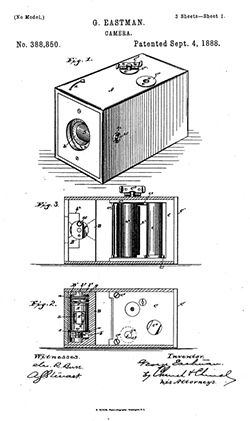 Eastman patents Kodak roll-film camera.
Eastman patents Kodak roll-film camera.
Louis Le Prince makes Roundhay Garden Scene. It is believed to be the first-ever motion picture on film.
 John Boyd Dunlop, trained as a veterinary surgeon, devises the first practical pneumatic tire in response to a request from his son for a more comfortable tricycle. His first effort involved an inflated section of garden hose, fitted to the rear wheels of the tricycle. Although born in Scotland, Dunlop spent most of his life in Northern Ireland, where his image occurs on the current £10 note, issued by the Northern Bank.
John Boyd Dunlop, trained as a veterinary surgeon, devises the first practical pneumatic tire in response to a request from his son for a more comfortable tricycle. His first effort involved an inflated section of garden hose, fitted to the rear wheels of the tricycle. Although born in Scotland, Dunlop spent most of his life in Northern Ireland, where his image occurs on the current £10 note, issued by the Northern Bank.
1888
 Heinrich Rudolf Hertz produces and detects radio waves for the first time. Radio waves will be called Hertzian waves until renamed by Marconi, who calls them radiotelegraphy waves.
Heinrich Rudolf Hertz produces and detects radio waves for the first time. Radio waves will be called Hertzian waves until renamed by Marconi, who calls them radiotelegraphy waves.
Nintendo is founded as Nintendo Koppai on 23 September 1889 by craftsman Fusajiro Yamauchi in Shimogyo-ku, Kyoto, Japan, as an unincorporated establishment, to produce and distribute Japanese playing cards, or karuta (from Portuguese carta, 'card'), most notably hanafuda ('flower cards').
Herman Hollerith lodges patent for Punch Card technology
The first commercially available transparent celluloid roll film is introduced by the Eastman Company, later renamed the Eastman Kodak Company and commonly known as Kodak.
1889
 George Francis Fitzgerald formulates the principle that objects shrink slightly in the direction they are traveling, now known as the Fitzgerald-Lorenz contraction, since Hendrik Antoon Lorentz reaches the same conclusion a few years later.
George Francis Fitzgerald formulates the principle that objects shrink slightly in the direction they are traveling, now known as the Fitzgerald-Lorenz contraction, since Hendrik Antoon Lorentz reaches the same conclusion a few years later.
Herman Hollerith designs tabulating machines for 1890 U.S. Census
Hypertext Pioneer Vannevar Bush Is Born
US Census Bureau announces results using Herman Hollerith's machine
1890
(no entry for this year)
Gabriel Lippmann announces a "method of reproducing colors photographically based on the phenomenon of interference".
William Kennedy Laurie Dickson develops the "kinetoscopic" motion picture camera while working for Thomas Edison.
1891
(no entry for this year)
(no entry for this year)
1892
(no entry for this year)
(no entry for this year)
1893
 Wilhelm Wien discovers that the maximum wavelength emitted by hot body varies inversely with its absolute temperature. Wien's law becomes useful in establishing the temperature of stars. The problems he has with deriving an equation to describe black-body radiation lead to Max Planck's introduction of the quantum in 1900.
Wilhelm Wien discovers that the maximum wavelength emitted by hot body varies inversely with its absolute temperature. Wien's law becomes useful in establishing the temperature of stars. The problems he has with deriving an equation to describe black-body radiation lead to Max Planck's introduction of the quantum in 1900.
(no entry for this year)
1894
 Joseph John (J.J.) Thomson announces that he has found that the velocity of cathode rays is much lower than that of light.
Joseph John (J.J.) Thomson announces that he has found that the velocity of cathode rays is much lower than that of light.
Auguste and Louis Lumi re invent the cin matographe.
 Cornflakes are invented in Battle Creek, Michigan, by John Harvey Kellogg — the chief medical officer of the Battle Creek sanitarium.
Cornflakes are invented in Battle Creek, Michigan, by John Harvey Kellogg — the chief medical officer of the Battle Creek sanitarium.
1895
 Charles Thomson Rees Wilson develops the CLOUD CHAMBER, a box containing a gas that is saturated. When a charged particle passes through the gas, small droplets are formed that make the track of the particle visible. The cloud chamber becomes a powerful tool in particle physics.
Charles Thomson Rees Wilson develops the CLOUD CHAMBER, a box containing a gas that is saturated. When a charged particle passes through the gas, small droplets are formed that make the track of the particle visible. The cloud chamber becomes a powerful tool in particle physics.
 Pierre Curie shows that as the temperature of the magnet is increased, there is a level at which the magnetism is disrupted and ceases to exist. This temperature is still called the Curie point.
Pierre Curie shows that as the temperature of the magnet is increased, there is a level at which the magnetism is disrupted and ceases to exist. This temperature is still called the Curie point.
 Wilhelm Konrad Röntgen (Roentgen) discovers X-rays, which will soon be applied in the visualization of bodily structures and in the induction of genetic mutations (both intentionally and accidentally).
Wilhelm Konrad Röntgen (Roentgen) discovers X-rays, which will soon be applied in the visualization of bodily structures and in the induction of genetic mutations (both intentionally and accidentally).
(no entry for this year)
1896
 Antoine-Henri Becquerel discovers rays produced by uranium — the first observation of natural radioactivity.
Antoine-Henri Becquerel discovers rays produced by uranium — the first observation of natural radioactivity.
America's first subway opens, in Boston.
Russian physicist Alexander Popov uses an antenna to transmit radio waves over a distance of 5 km.
1897
 Joseph John Thomson discovers the electron, the first known particle that is smaller than an atom, in part because he has better vacuum pumps that were previously available. He, and independently, Emil Wiechert, determine the ratio of mass to charge of the particles by deflecting them by electric and magnetic fields.
Joseph John Thomson discovers the electron, the first known particle that is smaller than an atom, in part because he has better vacuum pumps that were previously available. He, and independently, Emil Wiechert, determine the ratio of mass to charge of the particles by deflecting them by electric and magnetic fields.
Marie Curie begins research of "uranium rays" that will lead to the discovery of radioactivity.
Kodak introduces the Folding Pocket Kodak.
1898

 Marie and Pierre Curie discovered that thorium, gives off "uranium rays", which Marie renames RADIOACTIVITY.
Marie and Pierre Curie discovered that thorium, gives off "uranium rays", which Marie renames RADIOACTIVITY.
(no entry for this year)
1899
 British physicist Ernest Rutherford discovers the radioactivity from uranium has at least two different forms, which he calls alpha and beta rays.
British physicist Ernest Rutherford discovers the radioactivity from uranium has at least two different forms, which he calls alpha and beta rays.


 Fritz Geisel, Antoine-Henri Becquerel, and Marie Curie proved the beta rays consist of high-speed electrons.
Fritz Geisel, Antoine-Henri Becquerel, and Marie Curie proved the beta rays consist of high-speed electrons.
Kodak introduces their first Brownie, a very inexpensive user-reloadable point-and-shoot box camera.
1900
 Paul Karl Ludwig Drude shows that moving electrons conduct electricity in metals.
Paul Karl Ludwig Drude shows that moving electrons conduct electricity in metals.
 Paul Ulrich Villard is the first to observe a radiation that is more penetrating than X-rays, now called gamma rays.
Paul Ulrich Villard is the first to observe a radiation that is more penetrating than X-rays, now called gamma rays.
 On December 14, Max Planck announces the first step toward quantum theory. He states that substances can emit light only at certain energies, which implies that some physical processes are not continuous, but occur only in specified amounts called quanta.
On December 14, Max Planck announces the first step toward quantum theory. He states that substances can emit light only at certain energies, which implies that some physical processes are not continuous, but occur only in specified amounts called quanta.
Herman Hollerith patents Apperatus For Punching Record Cards
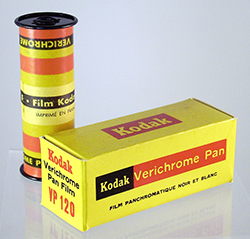 Kodak introduces the 120 film format.
Kodak introduces the 120 film format.
1901
(no entry for this year)
Arthur Korn devises practical telephotography technology (reduction of photographic images to signals that can be transmitted by wire to other locations).Wire-Photos are in wide use in Europe by 1910, and transmitted to other continents by 1922.
1902
(no entry for this year)
The first motor taxis appear in London
1903
Physicist Ernest Rutherford lectures the British Association that radioactivity could power the sun and maintain its heat, meaning the sun and Earth could be much older than Lord Kelvin's estimate.
The Rolls-Royce company is founded in Britain.
1904
(no entry for this year)
The first motorized buses operate in London.
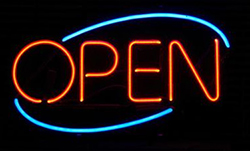 The first neon signs appear.
The first neon signs appear.
1905
Albert Einstein proposes the special theory of relativity (E=mc2).
Computer Pioneer Grace Hopper is Born
1906
(no entry for this year)
The Autochrome plate is introduced. It becomes the first commercially successful color photography product.
1907
(no entry for this year)
Kinemacolor, a two-color process known as the first commercial "natural color" system for movies, is introduced.
General Motors Corporation is formed.
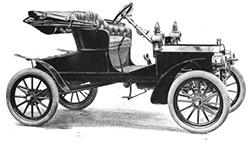 The Ford Motor Company produces the first Model T. Ultimately, more than 15 million will be produced.
The Ford Motor Company produces the first Model T. Ultimately, more than 15 million will be produced.
1908
(no entry for this year)
Kodak announces a 35 mm "safety" motion picture film on an acetate base as an alternative to the highly flammable nitrate base. The motion picture industry discontinues its use after 1911 due to technical imperfections.
The plastic age begins with the first commercial manufacture of Bakelite.
1909
(no entry for this year)
Three companies merge to become C-T-R
1910
(no entry for this year)
(no entry for this year)
1911
(no entry for this year)
Thomas Edison introduces a short-lived 22 mm home motion picture format using acetate "safety" film manufactured by Kodak.
Vest Pocket Kodak using 127 film.
1912
(no entry for this year)
 Roland Garros, a French aviator, becomes the first person to fly across the Mediterranean. Garros' original plan was to fly from St. Raphael in France to Bizerta, Tunisia, with the possibility of a fueling stop on Sardinia. En route, the trip seemed to be going well, so he skipped the refueling stop and flew directly to Bizerta, where he arrived at 1:45pm, with about five liters of fuel left in his tank.
Roland Garros, a French aviator, becomes the first person to fly across the Mediterranean. Garros' original plan was to fly from St. Raphael in France to Bizerta, Tunisia, with the possibility of a fueling stop on Sardinia. En route, the trip seemed to be going well, so he skipped the refueling stop and flew directly to Bizerta, where he arrived at 1:45pm, with about five liters of fuel left in his tank.
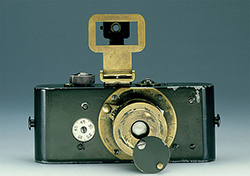 Oskar Barnack develops a prototype camera for testing 35mm movie film. This device, now often referred to as an UR-Leica, was quickly recognized as a miniature camera for producing still images. A dozen years later, the first commercially available 35mm still camera was marketed as the Leica I.
Oskar Barnack develops a prototype camera for testing 35mm movie film. This device, now often referred to as an UR-Leica, was quickly recognized as a miniature camera for producing still images. A dozen years later, the first commercially available 35mm still camera was marketed as the Leica I.
Kodak makes 35 mm panchromatic motion picture film available on a bulk special order basis.
 Hans Geiger unveils his radiation detector.
Hans Geiger unveils his radiation detector.
1913
(no entry for this year)
Thomas J. Watson Sr. joins C-T-R
Kodak introduces the Autographic film system.
The World, the Flesh and the Devil, made in Kinemacolor, is the first dramatic feature film in color released.
1914
(no entry for this year)
(no entry for this year)
1915
(no entry for this year)
(no entry for this year)
1916
(no entry for this year)
(no entry for this year)
1917
(no entry for this year)
Core memory inventor Jay Forrester is born
1918
(no entry for this year)
ENIAC Designer Presper Eckert Is Born
1919
(no entry for this year)
(no entry for this year)
1920
(no entry for this year)
(no entry for this year)
1921
(no entry for this year)
Kodak makes 35 mm panchromatic motion picture film available as a regular stock.
1922
(no entry for this year)
Integrated Circuit Co-Inventor Jack Kilby is Born
Harold Edgerton invents the xenon flash lamp for strobe photography.
The 16 mm amateur motion picture format is introduced by Kodak. Their Cine-Kodak camera uses reversal film and all 16 mm is on an acetate (safety) base.
1923
(no entry for this year)
C-T-R becomes IBM
1924
(no entry for this year)
First patent for a transistor in Canada lodged
January 1925 Douglas Engelbart is Born
Supercomputer Pioneer Seymour Cray is Born
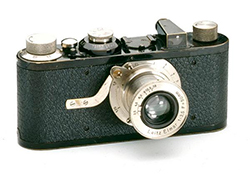 The Leica I 35mm still camera was introduced at the Leipzig Spring Fair in Germany, thereby launching the 35mm format for portable photography.
The Leica I 35mm still camera was introduced at the Leipzig Spring Fair in Germany, thereby launching the 35mm format for portable photography.
1925
(no entry for this year)
Kodak introduces its 35 mm Motion Picture Duplicating Film for duplicate negatives. Previously, motion picture studios used a second camera alongside the primary camera to create a duplicate negative.
1926
(no entry for this year)
(no entry for this year)
1927
(no entry for this year)
Introduction of 80-columns card format
1928
(no entry for this year)
Herman Hollerith Died
1929
(no entry for this year)
(no entry for this year)
1930
(no entry for this year)
(no entry for this year)
1931
(no entry for this year)
"Flowers and Trees", the first full-color cartoon, is made in Technicolor by Disney.
Kodak introduces the first 8 mm amateur motion picture film, cameras, and projectors.
1932
(no entry for this year)
(no entry for this year)
1933
(no entry for this year)
IBM 405 Alphabetical Accounting Machine introduced
The 135 film cartridge is introduced, making 35 mm easy to use for still photography.
1934
(no entry for this year)
Becky Sharp, the first feature film made in the full-color "three-strip" version of Technicolor, is released.
Introduction of Kodachrome multi-layered color reversal film (16 mm only; 8 mm and 35 mm follow in 1936, sheet film in 1938).
1935
(no entry for this year)
At Cambridge Alan Turing invented the principle of the modern computer
Konrad Zuse Files For Patent
Agfacolor Neu (English: New Agfacolor) color reversal film for home movies and slides.
Introduction by IHAGEE of the Ihagee Kine Exakta 1, the first 35 mm SLR (Single Lens Reflex) camera.
1936
(no entry for this year)
Alan Turing Defines the Universal Machine
ILLIAC IV Designer Slotnick is born
The Atanasoff–Berry Computer first conceived
1937
(no entry for this year)
Zuse Z1 built by Konrad Zuse
1938
(no entry for this year)
Hewlett Packard Founded
Agfacolor negative and positive 35 mm color film stock for professional motion picture use (not for making paper prints).
The View-Master 3-D viewer and its "reels" of seven small stereoscopic image pairs on Kodachrome film are introduced.
1939
(no entry for this year)
(no entry for this year)
1940
(no entry for this year)
Zuse Z3 machine completed
1941
(no entry for this year)
The Atanasoff-Berry Computer is completed
Kodacolor, the first color film that yields negatives for making chromogenic color prints on paper. Roll films for snapshot cameras only, 35 mm not available until 1958.
1942
(no entry for this year)
The Colossus Mark 1 computer is delivered to Bletchley Park
The First Computing Journal
Work begins on ENIAC
1943
(no entry for this year)
First Harvard Mark 1 shipped
1944
(no entry for this year)
Grace Hopper recorded the first actual computer "bug"
Patent is Filed for the Harvard Mark I
Vannevar Bush publishes his ideas for MEMEX, a proto-hypertext system and forerunner to the World Wide Web
1945
(no entry for this year)
Alan Turing Proposal For 'ACE' Automatic Computing Engine
ENIAC Unveiled
ENIAC, short for Electronic Numerical Integrator And Computer was announced
Frederick Williams Receives Patent for RAM device
1946
(no entry for this year)
J Lyons executives report on the potential of computers to automate clerical work
The Williams tube won the race for a practical random-access memory
Dennis Gabor invents holography.
Harold Edgerton develops the Rapatronic camera for the U.S. government.
1947
(no entry for this year)
IBM´s Selective Sequence Electronic Calculator was built
The Manchester Baby, the world's first stored program computer, ran its first program
Edwin H. Land introduces the first Polaroid instant camera.
1948
(no entry for this year)
EDSAC performed its first calculations
EDSAC ran its first programs
EDVAC goes onlline
Jay Forrester Records "Core Memory" Idea
Professor Bill Phillips unveils Phillips Hydraulic Economic Modelling Computer at the LSE
The Contax S camera is introduced, the first 35 mm SLR camera with a pentaprism eye-level viewfinder.
1949
(no entry for this year)
The first Elliott 152 computer appeared
Zuse sold first Z4 computer
1950
(no entry for this year)
Ferranti Mark 1 delivered to Manchester University
LEO I computer became operational
The first UNIVAC was delivered
UNIVAC-1 goes online
1951
(no entry for this year)
CBS News Uses UNIVAC Computer to Predict Election
Grace Hopper completes the A-0 Compiler
Heinz Nixdorf founded Nixdorf Computer
Bwana Devil, a low-budget polarized 3-D film, premieres in late November and starts a brief 3-D craze that begins in earnest in 1953 and fades away during 1954.
1952
(no entry for this year)
IBM announces the Model 650 computer
Jay Forrester installed magnetic core memory at MIT
1953
(no entry for this year)
20th September First FORTRAN Program Runs
IBM Announces Model 705 Computer
Jack Tramiel starts Commodore
Leica M Introduced
1954
(no entry for this year)
Apple Co-Founder Steve Jobs is Born
Bill Gates, cofounder of Microsoft Corporation, was born
English Electric Deuce Computers introduced
ENIAC is retired
1955
(no entry for this year)
First keyboard used to input data
IBM brings out the Magnetic Disk Memory
IBM introduces the IBM 350
Jay Forrester Receives Patent on "Core" Memory
Pegasus, produced by Ferranti Ltd., went into service in March 1956
Wang Sells Core Memory Patent to IBM
1956
(no entry for this year)
BCS - British Computer Society is Founded
CDC Introduces 1604 Computer
DEC is founded
Ferranti Mercury Introduced
FORTRAN-1 is formally published
May 1957 LEO II Installed
First Asahi Pentax SLR introduced.
First digital computer acquisition of scanned photographs, by Russell Kirsch et al. at the U.S. National Bureau of Standards (now the NIST).
1957
(no entry for this year)
Jack Kilby created the first integrated circuit
1958
(no entry for this year)
COBOL is introduced
The Xerox 914 is the first office copier for sale
AGFA introduces the first fully automatic camera, the Optima.
Nikon F introduced.
1959
(no entry for this year)
DEC released its first mini computer: PDP-1
1960
(no entry for this year)
Clive Sinclair founds Sinclair Radionics
Computerized spreadsheets for use in business accounting developed
LEO III completed in 1961
Minivac 601 Computer Launched
Robert Noyce Awarded Patent for "Integrated Circuit"
1961
(no entry for this year)
"Music from Mathematics" LP was created using an IBM 7090 computer
The first commercial Modem manufactured
The Machester Atlas was inaugurated on 7th December 1962
1962
(no entry for this year)
Douglas Engelbart Invents the Mouse
First edition of the ASCII standard was published.
Theodore H (Ted) Nelson coins the word Hypertext
Kodak introduces the Instamatic.
1963
(no entry for this year)
BASIC language developed
First operation of BASIC
First operation of Ferranti Atlas
Graphic tablet developed
IBM releases the System 360 range of commercial computers
Introduction of CDC 6600
Introduction of DEC PDP-7 18-bits minicomputer
First Pentax Spotmatic SLR introduced.
1964
(no entry for this year)
Commodore Business Machines (CBM) is founded.
DEC unveils the PDP-8,
Introduction of Wang 300 electronic calculator
Moore's Law coined
1965
(no entry for this year)
Introduction of DEC PDP-9
The hand-held pocket calculator was invented at Texas Instruments in 1966
1966
(no entry for this year)
Barclays Bank in the UK claims to have installed the first cash dispenser
Elliott Automation merged with English Electric
Introduction of DEC PDP-10
First MOS 10 by 10 active pixel array shown by Noble
1967
(no entry for this year)
CDC Introduces the 7600 Supercomputer
Douglas C. Engelbart publicly demonstrates the mouse
IBM tests a 8in floppy disc
Integrated Circuits First Used in Apollo Moon shot
Introduction of HP-9100 desk calculator
Robert Noyce and Gordon Moore found Intel Corporation
T J Watson and IBM granted patent for the DRAM
1968
(no entry for this year)
AMD Advanced Micro Devices is founded
ARPANET launch the world's first successful packet-switched wide area computer network
DEC PDP-15 Introduced
First flight to Moon of Apollo XI with Raytheon Apollo Guidance Computer
Honeywell releases the H316 "Kitchen Computer",
Intel announces a 1 kilobit RAM chip
Plessey buys out Ferranti's numerical Control Interests
1969
(no entry for this year)
5200 computers installed in Britain
Computer terminals in homes predicted for 1980
DEC introduces the PDP-8/E
IBM 370/145 introduced
Open University to install ICL 32K 1902A computer
Univac 1110 is introduced
UNIX is developed
Xerox opens the Palo Alto Research Center (PARC)
1970
(no entry for this year)
Burroughs introduces L500 Visible Record Model
DEC launches Giant Mini PDP-11/45
DEC launches PDP-11/03
Decsystem 10 introduced
First Network Email sent by Ray Tomlinson
IBM's Thomas J Watson retires
Intel Introduces the World's First EPROM
Intel Launches the First Microprocessor - The 4004
Nixdorf merge with AEG-Telefunken
Olivetti launches P602 "minicomputer"
1971
(no entry for this year)
£1.3m RAF order for Cossor Terminals
370/125 and OCR reader from IBM
ARPA Network - UK gets link to major US network
ASC developed by Texas Instruments
Atanasoff Official "Inventor" of Computer
Atari Introduces Pong
Burroughs Launch L8000 Range of Computers
Burroughs launches L7000 range on UK market
C programming language developed
Clive Sinclair introduces the first pocket calculator
Development of standard OS to be halted
First e-mail program developed
First Infra-red Data Link transmission in the UK
Flat screen terminal introduced by Burroughs
Foundation of Cray Research Inc by Seymour Cray
Fujitsu and Hitachi in joint deal
GE Time Sharing Service
Hewlett-Packard introduces the HP-35
Honeywell's 700 range comes to the UK
IBM's DOS/VS
NCR 399
Problems with IBM 370/155 and 370/165
Sigma 6
SITA Network
Space Craft Pioneer 10 & 11 use Custom CPU in TTL
Terminal range boosted by Burroughs TC 3500
The Future of ICL as a British-controlled going concern
The Intel 8008 was introduced
The Magnavox Odyssey, the first video game console, is released
UK launch for Burroughs L8000 range
Worlds first IBM 370/135 installed in Britain
Integrated Photomatrix (Noble) demonstrates for 64 by 64 MOS active pixel array
1972
(no entry for this year)
8" floppy & first "Hard Drive introduced by IBM
Bob Metcalfe invents Ethernet
Britain exports more computing equipment than it imports
Gary Kildall writes CP/M
IBM 370/145 product range released
IBM in Nigeria
IMSAI is founded. In 1973
The Micral was the earliest commercial, non-kit personal computer
Xerox Alto personal computer was developed at Xerox PARC
Fairchild Semiconductor releases the first large image forming CCD chip: 100 rows and 100 columns of pixels.
1973
(no entry for this year)
GA LSI 12/16 and LSI16
introduction of Intel 8080 2MHz microprocessor
MITS completes the first prototype Altair 8800 microcomputer
NCR 250-6000
Philips P852M
The Z-80, 8 bit processor is designed by Zilog Corp
Xerox Palo Alto Research Center designed the Alto
1974
(no entry for this year)
Bill Gates and Paul Allen sign a licensing agreement with MITS
CP/M operating system finished
Cray 1A announced
First meeting of the Homebrew Club
Microsoft Founded
MITS Altair launched on the cover of Popular Electronics magazine
Bryce Bayer of Kodak develops the Bayer filter mosaic pattern for CCD color image sensors.
1975
(no entry for this year)
Apple 1 Released
Burroughs introduce the large B7700 series
Dec System 20 introduced
Intel introduce SBC-80/10 "computer on a card"
Last slide rule manufactured today
Seymour Cray demonstrates CRAY-1 - The first vector-processor supercomputer
Steve Wozniak, Steve Jobs and Ronald Wayne Found Apple Computer Inc.
The 5 1/4" flexible disk drive was introduced
Steadicam becomes available.
1976
(no entry for this year)
Commodore International shows its Commodore PET 2001
Radio Shack announces TRS-80 computer
Science of Cambridge Ltd Formed
The Apple II launched
The MK14 was introduced by Science of Cambridge
The RCA CDP1802 microprocessor was used in the Galileo spacecraft
1977
(no entry for this year)
Acorn Computers Ltd formed in Cambridge, UK
Texas Instruments introduced Speak & Spell
VisiCalc Spreadsheet is born
1978
(no entry for this year)
"VisiCalc" introduced
Acorn System 1 Launched
Apple II+ Launched
Microsoft moves from Albuquerque, New Mexico to Bellevue, Washington
1979
(no entry for this year)
Acorn Atom Launched
Apple Computer’s Initial Share Offering
Microsoft Signs Contract with IBM to Create Operating System
Sinclair ZX80 Launched
The Apple III was announced
1980
(no entry for this year)
Acorn BBC Micro Launched
HP-41 calculator Used In Space Shuttle
IBM announced that it was launching a personal computer using an Intel 8088
IBM introduces personal computer with Microsoft's 16-bit operating system, MS-DOS 1.0
Introduction of Osborne portable computer in a suitcase
Microsoft incorporates
Sinclair ZX81 Computer Launched
Space Shuttle uses Intel 8086 and RCA 1802
The first ‘portable’ computer is launched
VIC-20 Released in Europe & US
1981
(no entry for this year)
Commodore 64 Released
Dragon 32 Released
Introduction of Cray X-MP supercomputer
Introduction of Intel 80286 at 6 MHz, with 134,000 transistors
Sinclair launches the ZX Spectrum computer
Sinclair ZX Spectrum Launched
1982
(no entry for this year)
Apple Lisa Launched
Introduction of spreadsheet program 1-2-3 by Lotus,
Microsoft Introduced 2-button Mouse
Microsoft Introduces Windows
The famicom is released in Japan
1983
(no entry for this year)
Apple launches Macintosh 128K
Creation of Dell Computer Corporation by Michael Dell
First ARM Processors Powered Up
IBM and Compaq introduce the IDE interface
IBM’s new 3480 cartridge tape system introduced
Introduction of IBM PC/AT based on Intel 80286
Macintosh 512K Launched
Novelist William Gibson coins the term cyberspace
1984
(no entry for this year)
Commodore 128 Released
Cray X-MP Supercomputer Begins Operation
First Commodore Amiga Released
Introduction of Intel 386
Microsoft Windows Launched
Olivetti buy 49% of Acorn Computers
Steve Jobs founds NeXT Computers Inc.
1985
(no entry for this year)
Acorn BBC Master Compact Launched
Acorn BBC Master Launched
Apple Macintosh Plus launched
First PC virus is released with "Brain"
Microsoft moves to corporate campus in Redmond, Washington
Microsoft stock goes public
Nintendo NES released
Kodak scientists invent the world's first megapixel sensor.
1986
(no entry for this year)
Commodore release the Amiga 500 and the Amiga 2000
Macintosh II released
Windows 2 was launched
1987
(no entry for this year)
IBM announces 3 millionth PS/2 personal computer
RISC OS is released
The first worm experience appears
The NeXT (68030 CPU) computer is introduced after two years of research
Unisys takes over Convergent Technologies
1988
(no entry for this year)
Apple introduces the Macintosh SE/30
Apple Macintosh Portable Released
ICL introduces DRS model 40 and 45
Tim Berners-Lee toyed with the idea of web pages and hyperlinks
1989
(no entry for this year)
Commodore releases the Amiga 3000
Hubble Space Telescope uses 386 processor
Introduction of IBM RS/6000
Microsoft launches Windows 3.0
1990
(no entry for this year)
Apple releases the PowerBook 100
First E-mail From Space Is Sent from a Mac Portable
Linus Torvalds from Finland releases Linux version 0.02
Silicon & Synapse founded
Sun Microsystems Starts Java Technology
1991
(no entry for this year)
Commodore releases the the Amiga 500+
Internet freed from Government control
Microsoft Releases Windows 3.1
Photo CD created by Kodak.
1992
(no entry for this year)
Apple Newton Message Pad announced
Commodore released the CD32 model
Compaq Introduces Presario
Foundation of Nvidia
IBM Announces a loss of $4.97m for 1992
Intel Ships "Pentium" Chip"
Introduction of Apple Newton PDA
The Jet Propulsion Laboratory begins work on image-capturing devices using CMOS or active pixel sensors.
1993
(no entry for this year)
Netscape Communications Corporation is founded
Silicon & Synapse changes its name to Blizzard Entertainment
Yahoo founded January 1994
Nikon introduces the first optical-stabilized lens.
1994
(no entry for this year)
Microsoft launches Windows 95
Nvidia's NV1 launched
"Kodak DC40 and the Apple QuickTake 100 become the first digital cameras marketed for consumers."
1995
(no entry for this year)
Apple Computer buys NeXT
eBay is founded by Jeff Skoll and Pierre Omidyar
Eastman Kodak, FujiFilm, AgfaPhoto, and Konica introduce the Advanced Photo System (APS).
1996
(no entry for this year)
IBM's Deep Blue Beats Gary Kasparov at Chess
IBM announces RS/6000 SP Deep Blue
zon.com, an online bookseller, goes public
first known publicly shared picture via a cell phone, by Philippe Kahn.
1997
(no entry for this year)
Apple Release the iMac
Foundation of Google by Larry Page and Sergey Brin
Introduction of Apple iMac
Microsoft launches Windows 98
1998
(no entry for this year)
Napster the first file sharing program introduced
Nvidia releases GeForce 256
The Millennium bug is taken seriously
1999
(no entry for this year)
Intel ES7000 server from Unisys introduced
Microsoft launches Windows 2000
J-SH04 introduced by J-Phone, the first commercially available mobile phone with a camera that can take and share still pictures.[13]
2000
(no entry for this year)
Apple Launches a New Music Device - The iPod
Microsoft Releases Windows XP
2001
(no entry for this year)
Microsoft and partners launch Tablet PC
2002
(no entry for this year)
Microsoft launches Windows Server 2003
2003
(no entry for this year)
Firefox 1.0 Introduced
First Ubuntu Linux operating system Released
Microsoft returns $75 billion to shareholders
2004
(no entry for this year)
Google now indexes over 8 billion pages
AgfaPhoto files for bankruptcy. The production of Agfa brand consumer films ends.
2005
(no entry for this year)
Microsoft announces Bill Gates transition
Dalsa produces a 111 megapixel CCD sensor, the highest resolution at that time.
2006
(no entry for this year)
iPhone introduced
Microsoft launches Windows Vista and Office 2007
2007
(no entry for this year)
Android operating system released
The HD player war comes to an end
Virus Found On Computer In Space Station
Polaroid announces it is discontinuing the production of all instant film products, citing the rise of digital imaging technology.
2008
(no entry for this year)
FujiFilm launches world's first digital 3D camera with 3D printing capabilities.
Kodak announces the discontinuance of Kodachrome film.
2009
(no entry for this year)
Apple iPad Launched in the UK
Apple Surpasses Microsoft as Most Valuable Technology Company
First Tweet sent to Twitter on VIC-20
2010
(no entry for this year)
Steve Jobs retires as CEO of Apple
Steve Jobs, co-founder of Apple, dies age 56
Lytro releases the first pocket-sized consumer light-field camera, capable of refocusing images after being taken.
2011
(no entry for this year)
Google Brain watches Youtube, recognises cats.
Wii U released
Wikipedia and others Go Dark in protest anti-piracy law
2012
(no entry for this year)
Edward Snowden Leaks Top Secret Documents
PlayStation 4 released
Suicide of Aaron Swartz
Xbox One released
2013
(no entry for this year)
Amazon buys Twitch for £585m
Android watches go up for preorder
Bill Gates returns to Microsoft as Technology Adviser
Bletchley park officially opens to the public
Facebook buys Oculus
Facebook buys WhatsApp
Nvidia at GPU Technology Conference
The Queen opens a new 'Information Age' Gallery at the Science Museum
2014
(no entry for this year)
Apple posts biggest quarterly profit in history
Apple reveals Apple Watch
Microsoft reveals HoloLens headset
2015
(no entry for this year)
(no entry for this year)
2016
(no entry for this year)
(no entry for this year)
2017
(no entry for this year)
(no entry for this year)
2018
(no entry for this year)
(no entry for this year)
2019
(no entry for this year)
(no entry for this year)
2020
(no entry for this year)
(no entry for this year)
2021
(no entry for this year)
(no entry for this year)
2022
(no entry for this year)
(no entry for this year)
2023
(no entry for this year)
(no entry for this year)
2024
(no entry for this year)
(no entry for this year)
2025
(no entry for this year)
(no entry for this year)
2026
(no entry for this year)
(no entry for this year)
2027
(no entry for this year)
(no entry for this year)
2028
(no entry for this year)
(no entry for this year)
2029
(no entry for this year)
ESP Quick Facts
ESP Origins
In the early 1990's, Robert Robbins was a faculty member at Johns Hopkins, where he directed the informatics core of GDB — the human gene-mapping database of the international human genome project. To share papers with colleagues around the world, he set up a small paper-sharing section on his personal web page. This small project evolved into The Electronic Scholarly Publishing Project.
ESP Support
In 1995, Robbins became the VP/IT of the Fred Hutchinson Cancer Research Center in Seattle, WA. Soon after arriving in Seattle, Robbins secured funding, through the ELSI component of the US Human Genome Project, to create the original ESP.ORG web site, with the formal goal of providing free, world-wide access to the literature of classical genetics.
ESP Rationale
Although the methods of molecular biology can seem almost magical to the uninitiated, the original techniques of classical genetics are readily appreciated by one and all: cross individuals that differ in some inherited trait, collect all of the progeny, score their attributes, and propose mechanisms to explain the patterns of inheritance observed.
ESP Goal
In reading the early works of classical genetics, one is drawn, almost inexorably, into ever more complex models, until molecular explanations begin to seem both necessary and natural. At that point, the tools for understanding genome research are at hand. Assisting readers reach this point was the original goal of The Electronic Scholarly Publishing Project.
ESP Usage
Usage of the site grew rapidly and has remained high. Faculty began to use the site for their assigned readings. Other on-line publishers, ranging from The New York Times to Nature referenced ESP materials in their own publications. Nobel laureates (e.g., Joshua Lederberg) regularly used the site and even wrote to suggest changes and improvements.
ESP Content
When the site began, no journals were making their early content available in digital format. As a result, ESP was obliged to digitize classic literature before it could be made available. For many important papers — such as Mendel's original paper or the first genetic map — ESP had to produce entirely new typeset versions of the works, if they were to be available in a high-quality format.
ESP Help
Early support from the DOE component of the Human Genome Project was critically important for getting the ESP project on a firm foundation. Since that funding ended (nearly 20 years ago), the project has been operated as a purely volunteer effort. Anyone wishing to assist in these efforts should send an email to Robbins.
ESP Plans
With the development of methods for adding typeset side notes to PDF files, the ESP project now plans to add annotated versions of some classical papers to its holdings. We also plan to add new reference and pedagogical material. We have already started providing regularly updated, comprehensive bibliographies to the ESP.ORG site.
ESP Picks from Around the Web (updated 06 MAR 2017 )
Old Science

Weird Science

Treating Disease with Fecal Transplantation
Fossils of miniature humans (hobbits) discovered in Indonesia

Dinosaur tail, complete with feathers, found preserved in amber.
Astronomy

Mysterious fast radio burst (FRB) detected in the distant universe.